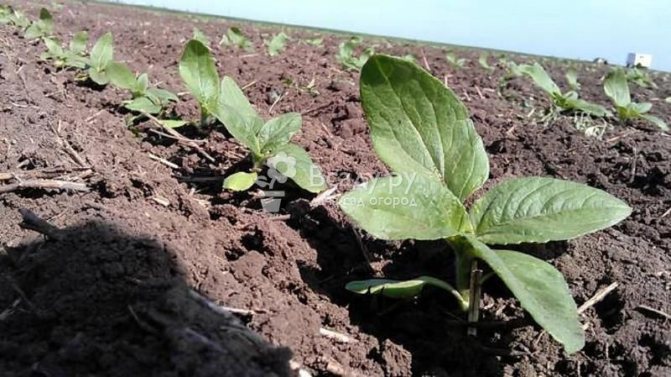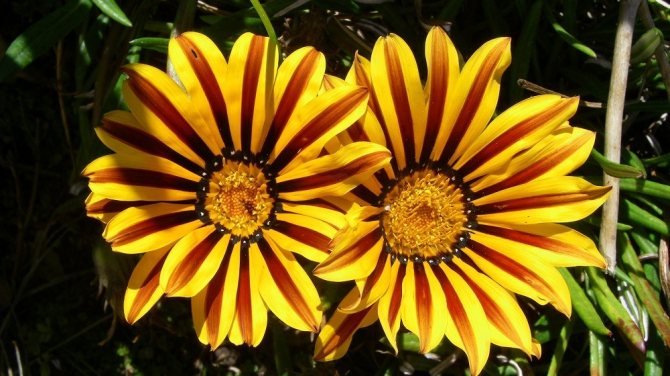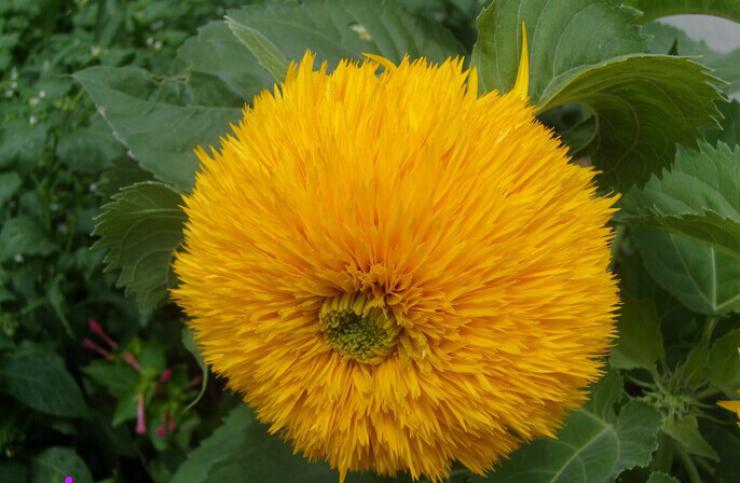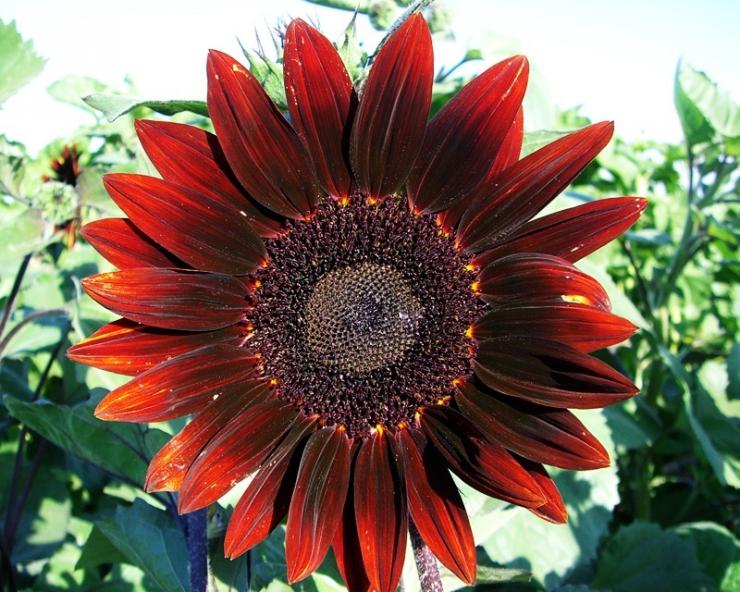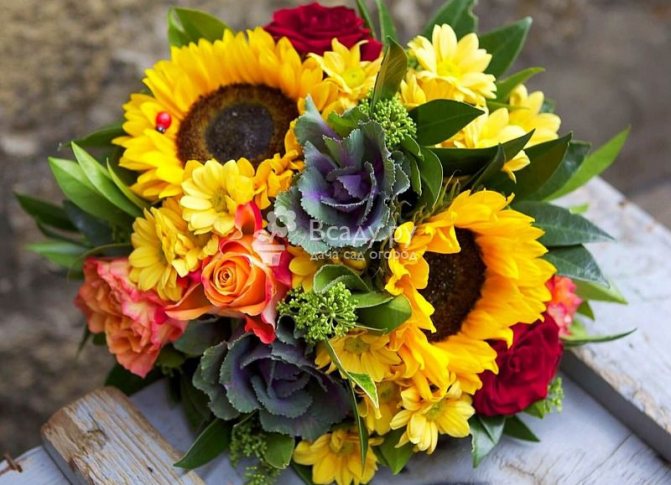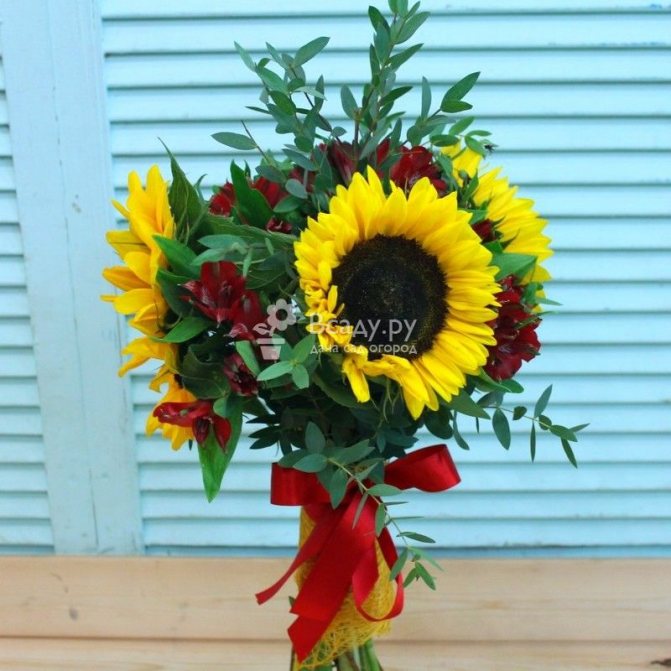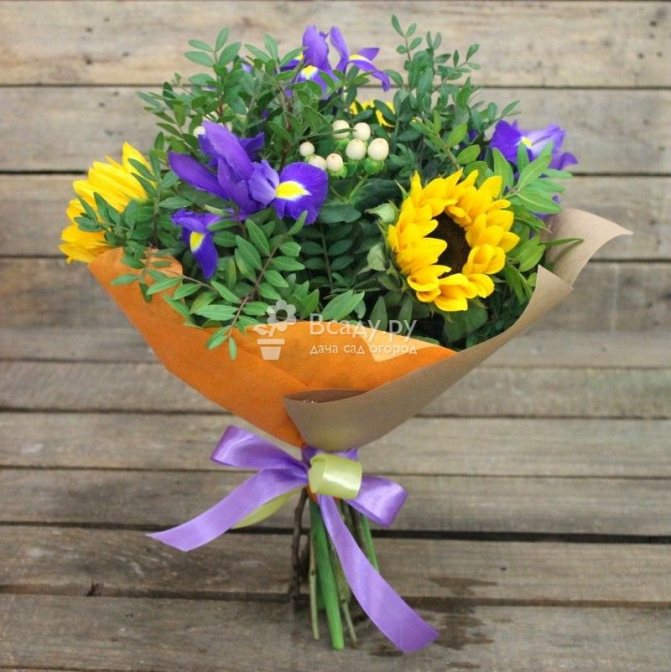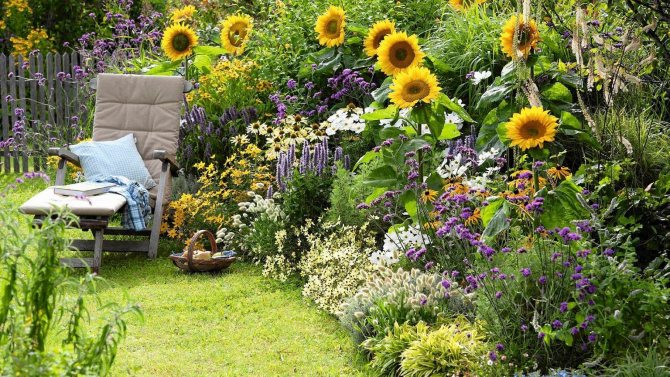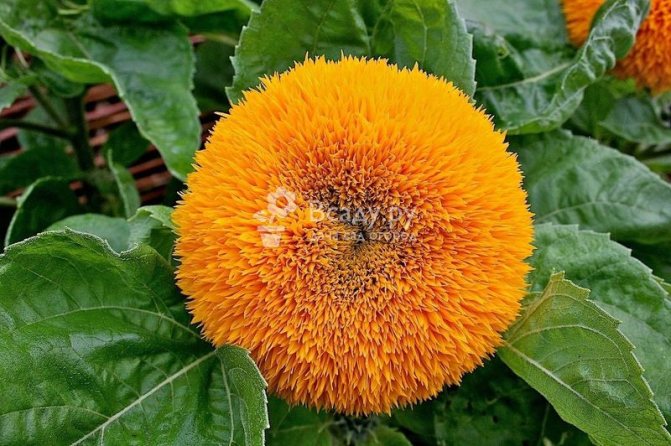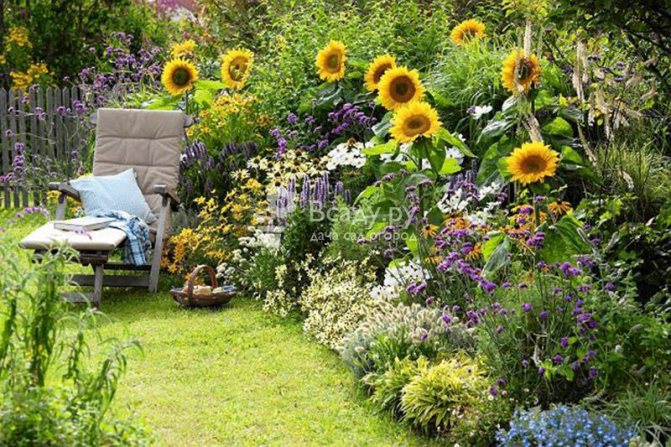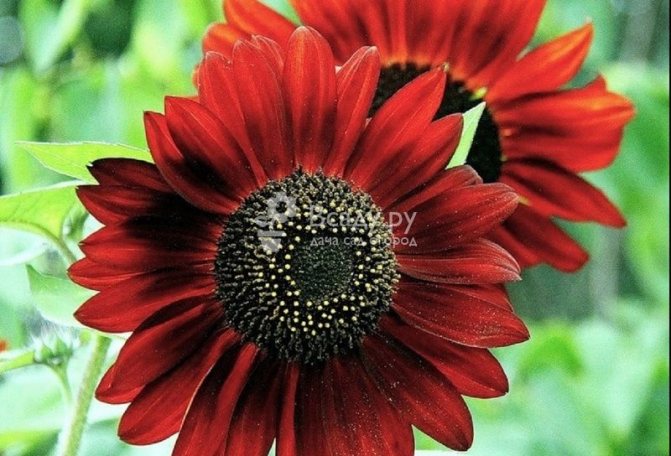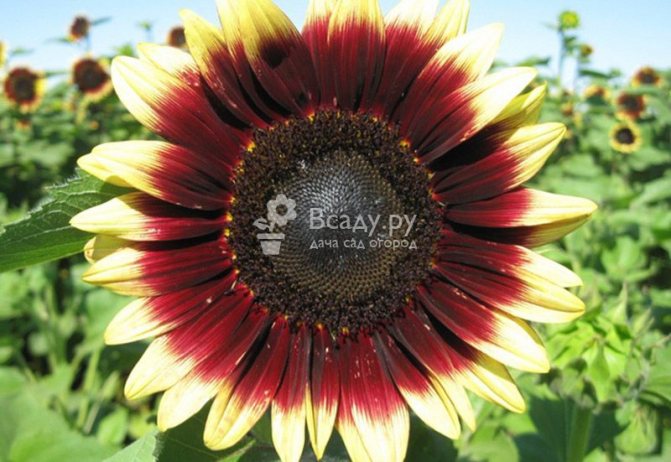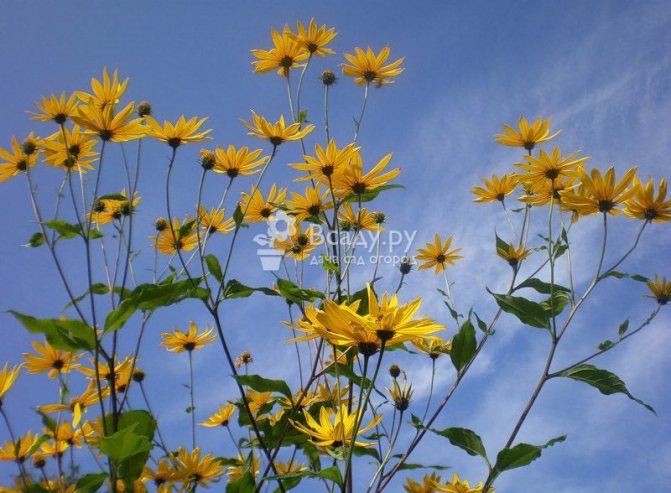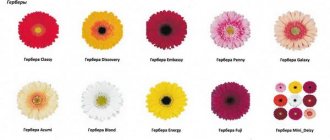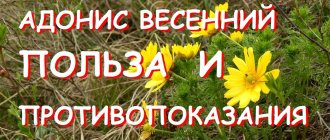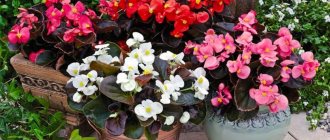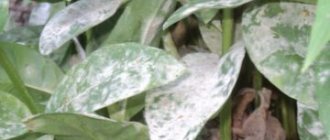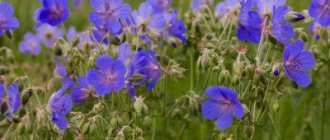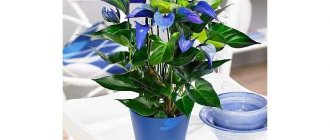Among the many varieties of flowering plants, there are flowers that look like sunflowers. All of them belong to the Asteraceae or Asteraceae family. Baskets (inflorescences) in representatives of the family have a round shield-like shape.
The peduncles of these plants are complex, that is, what we call a "sunflower flower" is an inflorescence of several dozen flowers adjoining each other in one receptacle. The bed is flat, concave or convex.
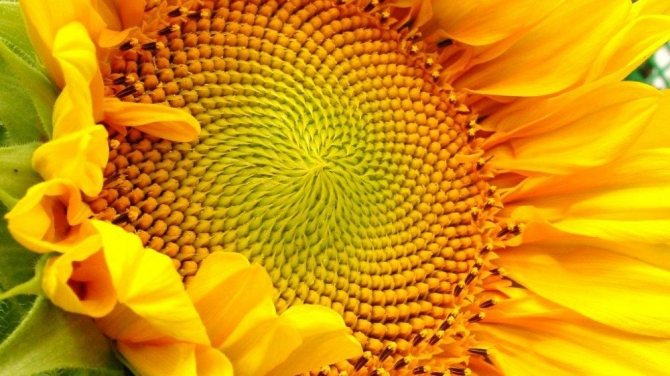
The sunflower flower resembles a miniature sun
In all Compositae plants, similar to small sunflowers, small, thin tubular flowers grow in the center of the basket, reed flowers grow along its edges, which create a lush corolla.
Tubular flowers are tightly adjacent to each other. It is from them that the seeds grow. The receptacle is immersed in a solid base - a calyx, around which small leaves (bracts) grow, framing a basket. They protect the inflorescence until it has formed and opened.
It cannot be said that the common ancestor of all aster plants was the wild-growing sunflower, once brought by the Spaniards from America, but the similarity of the structure of aster plants with agricultural sunflower is undoubted.
Growing a decorative sunflower from seeds
Ornamental sunflowers most often mean annual helianthuses. A large selection of varieties and shapes, simple and terry, but invariably dazzling seasonal stars - just one of the reasons for the continued popularity of sunflowers. After all, these plants are so easy to reproduce that even inexperienced flower growers can grow guardians of summer. The right choice of location, timely sowing and care of young plants - that's all you need to admire the luxurious heads of sunflowers on your flower garden.
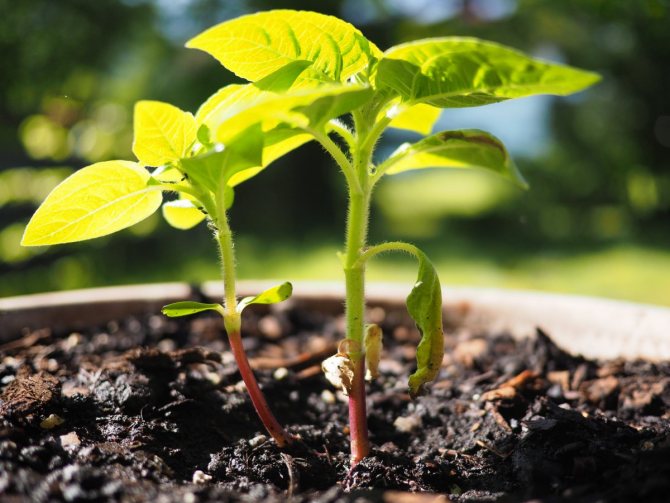

Annual sunflowers are one of the most popular seasonal plants. Their appearance is well known to both gardeners and those who do not grow plants on their own. The largest basket inflorescences of all possible are easily recognized even in the company of crops related to the type of flowering. But understanding the variety of annual sunflowers is not as easy as identifying their luxurious heads in a flower bed. On bags with seeds, the type of sunflowers is often not specified and the seeds are simply labeled as Helianthus, although annual representatives of the genus and all their varieties have long been combined into a species annual sunflower(Helianthus annuus). Flowering of annual sunflowers traditionally lasts from July to October. Single-stemmed annuals with thick, erect shoots, crowned at the tops of strikingly large baskets of inflorescences with a diameter of 5 to 36 cm, sunflowers are easily recognizable. And not only in the classically large center of numerous tubular or ligulate flowers arranged in strict rows, but also in the bristly pubescent, rough to the touch, inimitably wrinkled, heart-shaped serrated leaves of a rich color located alternately on the petioles, as well as in the beautiful bracts around the basket, and according to the power of their peduncles.
Annual sunflowers also have dwarf ones, only up to half a meter high, or even lower, varieties and real giants.Decorative forms (variegated, round bloated, round multi-flowered, Californian) and hundreds of different varieties allow you to choose annual sunflowers to your liking. Yellow, orange, red, white, brown, variations of a monochromatic or two- and three-color color, different degrees of double and semi-double, the size of the center and the location and even the shape of the petals significantly affect the decorativeness of sunflowers and the possibility of their use. But all this diversity has no effect on the reproduction of annual sunflowers. They are grown only from seeds and more often they use not seedlings, but the simplest method - sowing directly at the growing site, that is, directly into the soil.
Sunflower propagation methods:
- Sowing directly on site in spring.
- Sowing seedlings in early spring.
Calendula
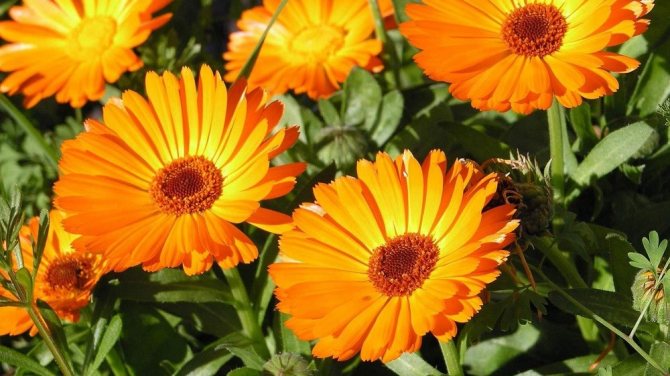

Calendula inflorescences are simple (with one or two rows of petals), semi-double and double. Corolla color is deep orange or light yellow. The reed petals are evenly colored, but in some varieties the color becomes lighter towards the middle. The tubular flowers are orange. They can be dyed in a more saturated color than reed ones.
Leaves of calendula are elongated, lanceolate, light green, the stems of the plant moderately branch. The flower bushes grow up to 30-60 cm in height. There are large and small varieties of calendula. The size of inflorescences-baskets in different varieties ranges from 3 to 10 cm.
A complete overview of calendula - growing and care
Self-collection of sunflower seeds and their selection for sowing
Even the most fashionable varieties of sunflower produce abundant self-seeding, but collecting the seeds of the varieties you like from this plant is not difficult. Inversely ovate faceted achenes in flat baskets make it easy to assess the degree of seed ripening (by their darkening).
The most difficult thing in collecting seeds of ornamental sunflowers is to protect the crop from birds who love to feast on seeds of even annual varieties. As the seeds form, the inflorescences from which they plan to harvest are necessarily tied with a net, transparent cloth or gauze to prevent the birds from getting to the precious seeds. After cutting off the heads, the seeds are not removed from the seed fruits, but they are allowed to dry completely. You can store seeds without removing them from the baskets, and in "pure" form.
Seeds of ornamental sunflowers retain their germination for a very long time: even in the third or fourth year after harvest, annual sunflowers emerge, albeit not with an efficiency of 90%, but quite amicably.
The main thing in buying seeds of varieties and mixtures of decorative sunflowers is to choose trusted producers. Too cheap seeds of dubious firms may not give a single germination at all. Pay attention to the completeness of information about the manufacturer, study its reputation, average prices in the market. For the rest, you can only focus on the height and aesthetic qualities of the inflorescences. Before sowing, the seeds are sorted, rejecting damaged and small ones (if desired, they can be sown separately for the experiment).
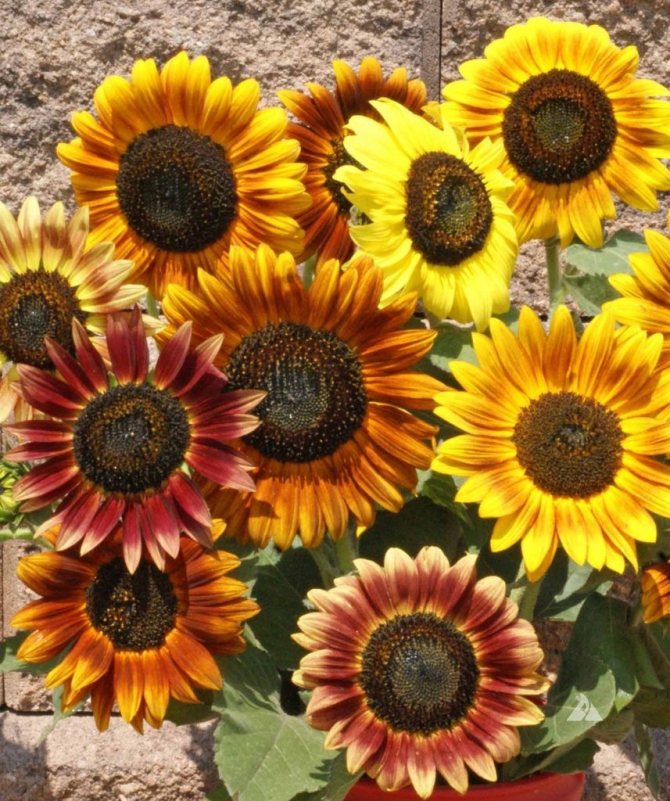

Ornamental sunflower inflorescences
Kosmeya yellow (sulfur yellow)
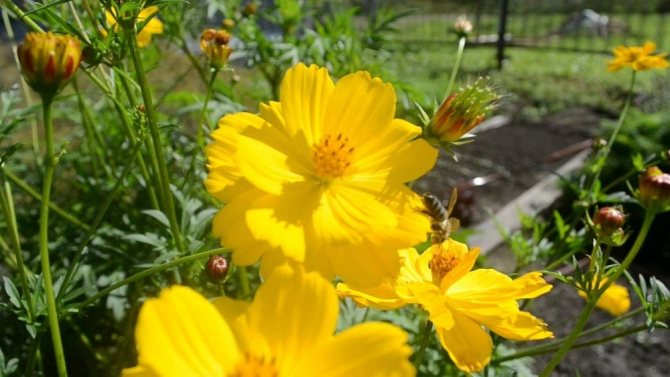

Two varieties of sulfur-yellow Cosmea are popular among flower growers - Bilbo and Krest Lemon. It is a heat-loving plant that is drought tolerant.
The diameter of the inflorescences in this species is small - 5-7 cm. The ligulate flowers are painted in rich yellow, sulfur-yellow, orange and red-orange colors. The tubular flowers in the center of the basket are most often yellow.
Thanks to the lush foliage, the sulfur-yellow Kosmeya completely covers the soil. The leaves of this plant are rugged, feathery and lanceolate. The Bilbo variety blooms with semi-double orange baskets and grows to a height of 50-80 cm. The Lemon Cross belongs to undersized and reaches 40 cm.
Planting and growing cosmos from seeds - a complete overview
Place for sowing decorative sunflowers
The very name of helianthus directly indicates the conditions in which these delightfully summer flowers prefer to grow. Annual sunflowers are the same sun worshipers as ordinary sowing or perennial helianthuses. They need the brightest, most open, sunny areas. For low varieties of sunflowers, windiness is not terrible, but for tall and especially giant sunflowers, up to 3 m high or planted in curbs and screens, you need to choose protected, warm, windproof areas. Even miniature varieties with a height of about 30 cm in windy places develop smaller and not so bright inflorescences.
Much more attention should be paid to soil parameters. For annual sunflowers, it should be light and loose. Sandstones are preferable, but provided that sand is applied to improve the structure, helianthus can grow on loam and clay soil. Wet or fresh soils with a high nutrient content will allow the annual helianthus to express its beauty in full. Annual sunflowers do not tolerate soil salinity and acidic environment.
Read also: Black radish chemical composition
Sunflowers are not grown without interruption in the same place, after nightshades, legumes and beets.
Gelenium
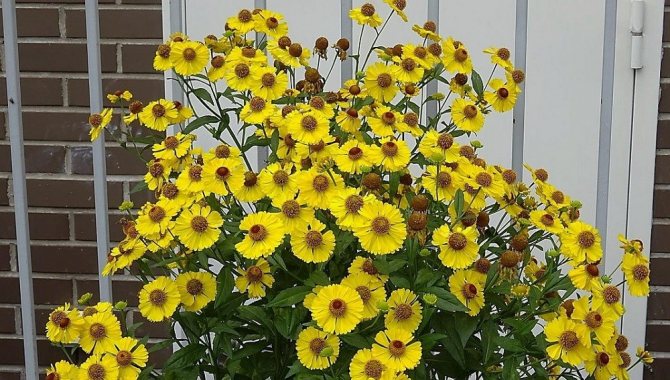

Among the numerous varieties of this plant, Gelenium autumn yellow and Gelenium Canaria are similar to small sunflowers. The baskets of this plant are solitary, but more often corymbose, collected in inflorescences. The receptacle is surrounded by ligulate flowers of reddish, purple, orange, brown and yellow colors. In the center of the basket, on a strongly convex bed, there are tubular flowers (brown or yellow).
Autumn yellow Gelenium grows up to 3 meters in height and produces inflorescences 4-6 cm in diameter. Gelenium Canaria (Canaria) grows up to 150 cm, its baskets with a diameter of 3.5-5 cm form corymbose apical inflorescences.
Learning to grow helenium outdoors
Sowing dates of decorative sunflower in the soil
In regions where the soil warms up early, the choice of possible planting dates and stretching the sowing period for several months allows you to increase the flowering time for almost the entire season. You can sow sunflower in the south in the fall, before winter, at the end of March-April.
In regions with severe winters, annual sunflowers are traditionally sown at the end of April when the weather is favorable, but more often only in May. There is no need to be afraid of early sowing: despite the fact that the sunflowers themselves are not cold-resistant and wither with the arrival of frosts, the seedlings perfectly tolerate return frosts down to -6 degrees, which allows sowing ornamental sunflowers a little earlier than ordinary annuals. Usually, plants are recommended to be sown when the soil warms up to about 10 degrees Celsius.
It is worth "stretching" the sowing in any case, dividing the seeds into portions for sowing at intervals of 1 week. If you carry out additional sowing of decorative sunflowers throughout the summer, then the parade of sunflowers will continue until the first frost and will be uninterrupted.
Seat selection
It is not for nothing that a sunflower is called a sunny flower, it loves the sun very much. The landing site should be open, light shade is allowed. In the shade, the plant will also grow, but will be weak and frail.
The soil should be loose and light, with good drainage. For annuals, sandy loam is preferred. They do not tolerate an acidic environment and soil salinity. It is advisable that the place is not windy, as strong gusts can break tall plants.
It should be noted that sunflowers take a large amount of nutrients from the ground. Next year, either siderates or legumes can be planted at their planting site so that they can restore the supply of these substances.
An open place is selected for the sunflower.It should be illuminated by a daylight for at least 6-8 hours a day. At the same time, plants need protection from the wind. How are sunflowers planted? Under the walls of buildings or along the fence - many gardeners know this. This arrangement solves two problems at once: the structures protect the plants from the winds, and the sunflowers themselves serve as an excellent decor. They can close a not-too-pretty fence or an unassuming tool shed.
The soil should be fertile, it is possible with an average clay content. Sunflower will not grow on swampy, salty, acidic soil. The best options are black soil, chestnut and gray forest soils. Legumes, tomatoes or sugar beets cannot be the predecessors of the crop. After them, a lot of nitrogen remains in the soil. It is better to sow sunflower on the site after grain crops.
Sowing ornamental sunflower seeds
There is nothing complicated in the process of sowing ornamental sunflower varieties. You can soak the seeds in water for a day and pickle them in fungicides (even in a weak solution of potassium permanganate) to increase resistance to pests and diseases. If the number of seeds is limited, it is advisable to germinate on a damp cloth or paper towel, doing a gentle pinching or cutting off the top of the seed to accelerate germination.
Seeds are sown in grooves or individual pits, deepening them by about 2-4 cm (the maximum deepening, which does not affect the development of sprouts, is 5 cm). It is advisable to sow ornamental sunflower sparsely in order to avoid the need to thin out the seedlings. Usually, seeds are laid out in 2-3 pieces at a distance of 30 cm for undersized to 70 cm for the tallest sunflowers.
The first shoots of annual sunflowers usually appear within a week after sowing.
After the shoots appear and get stronger, the excess plants are removed, leaving the strongest ones.
Flowering from May crops can be expected in July. But it is much easier to focus on the duration of the growing season: annual sunflowers will bloom in 75, in extreme cases - 90 days.
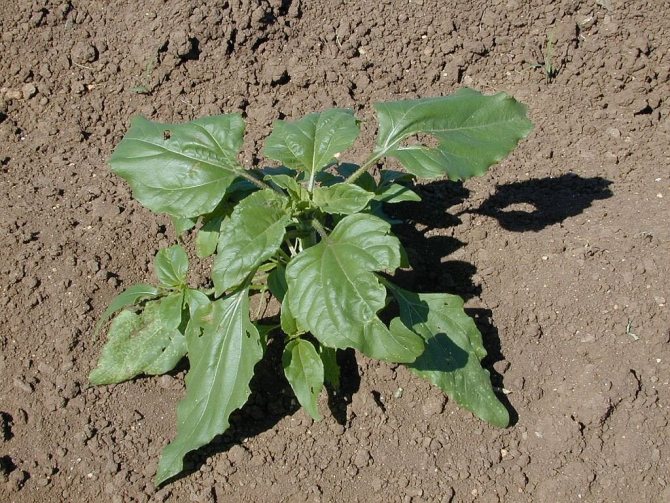

Young ornamental sunflower seedling
When to plant seedlings outdoors?
In the southern regions, the land warms up early, so seeds can be planted already in late March and early April. In the middle lane, sunflowers should be planted from the end of April.
In regions with a harsh climate (Siberia, the Urals, the Far East), it is better to sow helianthus in May. But, if the weather is favorable, this can be done at the end of April. You should not be afraid of early sowing: young seedlings tolerate frosts up to -5 degrees perfectly.
If you are going to plant decorative sunflowers on your site, it is better to focus not on the timing, but on the weather. The most favorable time for planting seeds is when the soil warms up to 10 degrees.
The sowing period can be extended throughout the summer, so you can ensure the flowering of sunflowers almost throughout the season. Plant seeds at intervals of 1-2 weeks and a colorful parade of sunflowers will delight you all summer and the first half of autumn.
There is nothing difficult in sowing ornamental sunflower seeds.
Follow the instructions below:
- Dig holes 5-6 cm deep. The distance between the pits should be 30-40 cm for low-growing sunflowers, 50-70 cm for tall plants. The distance between the rows is 70-80 cm.
- Put 2-3 seeds in each hole and deepen them by about 2-4 cm.
- Fill the holes with soil, level the rows with a rake and gently pour from the watering can.
Usually, the first shoots appear after 7-10 days. As they get stronger, remove the weak shoots and leave only the strongest. If all of the 2-3 planted seeds sprout, then with further growth they will only interfere with each other.
Annuals will bloom in about 70-95 days.
Before planting sunflower seeds in the open field, you need to make sure that it is warmed up well.The temperature cannot be lower than 8-120 C at a depth of 10 cm. Planting dates are determined by this very indicator and may vary depending on the climate. This is usually the beginning or mid-May.
The optimum air temperature for sowing is 10-12 degrees Celsius. Sprouts can appear as early as 15 days after sowing. A lower temperature (6-8 degrees) will delay germination, they will germinate 20 days or even later. The culture easily tolerates frosts down to -50 C, does not require abundant watering.
How to plant sunflower seeds in the ground depends on the size of the crop. Small and ornamental plants are planted according to the 30x50 scheme, large - 75x90, very large - 90x120 cm.The depth can vary from 5 cm to 10 cm in the northern regions, it is also influenced by the choice of the variety. 2-3 seeds are thrown into the hole, sprinkled with earth, watered and rolled.
This can be done as soon as the warm weather is finally established.
Most of the sunflowers are annual crops. But perennials also happen. The most famous is Jerusalem artichoke or earthen pear. There is another interesting variety of ornamental sunflower - this is Helianthus tuberosus, in which tubers are formed on the roots.
Perennial sunflowers also include a ten-petal species.
And among the annuals, the varieties Teddy Bear, Red Sun, Kong, etc. stand out with a large and bright hat.
One has only to look at the photo of these beautiful flowering plants, as the mood instantly rises and there is a reason for smiles and good mood.
Care of young shoots of ornamental sunflower
Sunflower can be affected by birds, snails and even rodents long before germination and during the germination stage. It is better to immediately spread the bait from slugs and snails, but you can save sunflower crops from birds by simply covering the soil with a net or film.
Despite the status of sun worshipers, it would be a big mistake to classify decorative sunflowers as drought tolerant plants. They are hygrophilous and the beauty of flowering directly depends on watering. Drought during the period of active development of greenery and peduncle necessarily affects flowering, therefore watering is provided already from the stage of young shoots. Waterlogging, dampness of the soil are dangerous to the same extent as the complete drying of the soil. Watering is carried out when there is not enough rainfall, about 1 time per week in heat and drought, soaking the soil to the entire depth of the roots of helianthus.
Top dressing for sunflower, provided that the soil is sufficiently nutritious, can not be carried out at all. If the soil has not been improved, then about a month after the emergence of seedlings, you can feed the sunflowers with nitrogen fertilizers, and at the stage of budding and flowering - with full mineral or potassium-phosphorus fertilizers.
It is better to tie tall varieties of sunflowers to supports as they grow, especially if the plants are nevertheless planted in windy areas. For sunflowers, a simple peg is sufficient.
In adult annual sunflowers, further care is reduced to several procedures:
- watering;
- loosening the soil;
- removing weeds;
- removal of faded bushes (if you kept the inflorescences, you should not rush to cut them, because the sunflower will not only decorate autumn and winter flower beds, but also serve as an additional source of food for birds).
Removing wilted flowers from a sunflower accelerates the blooming of new buds and prevents drooping of flower heads. If you are growing plants for cutting, then it is really better to cut the inflorescences in time (with the exception of a few "heads" left for collecting seeds). But if you just decorate the garden with sunflowers and place accents, then leave as many inflorescences as possible: they will serve useful birds in the garden no worse than regularly filling the feeders. Yes, and will delight your eyes.
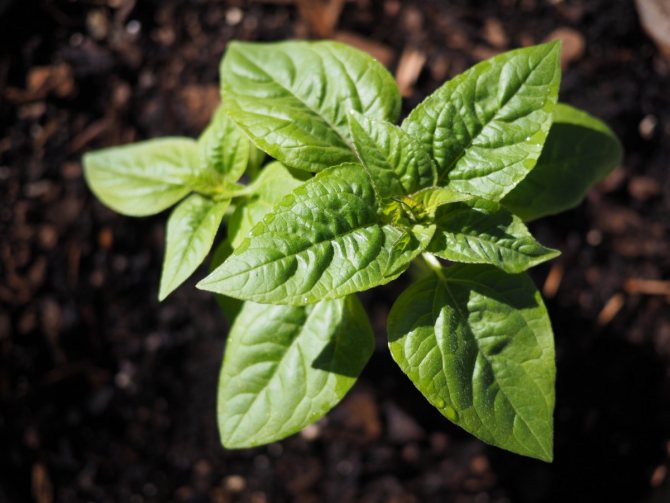

Growing seedlings of decorative sunflower.
Seed preparation
If the question arises about how sunflowers are planted, then first of all you need to worry about the preparation of seeds and the selection of varieties. Many people prefer to grow crops specifically to get seeds - delicious "entertainment" for all family members.
First, the seeds are carefully calibrated. They should be the same size, full-bodied, not damaged.
The next stage is seed dressing. Experienced gardeners recommend using this composition: the garlic is passed through a meat grinder, mixed with onion peel (in equal proportions), and then poured with boiling water. Two liters of water will require 100 grams of garlic. The mixture is infused for a day, filtered through cheesecloth.
Before planting, the seeds are soaked overnight. This simple processing has its advantages: firstly, it is an environmentally friendly "poison", and secondly, the pungent smell will scare away pests and rodents from eating seeds. White threads stretched above the ground can provide additional protection from birds.
Choose a sunny place for planting. Fertile soil will eliminate the need to feed the sunflower. Harsh gusts of wind can break fragile stems, choose a protected place. Ornamental annuals are propagated by seeds. Their preparation is very simple:
- make an aqueous solution of wood ash;
- saturate the fabric with it;
- wrap seeds in it;
- soak for a day, moisturizing the fabric if necessary
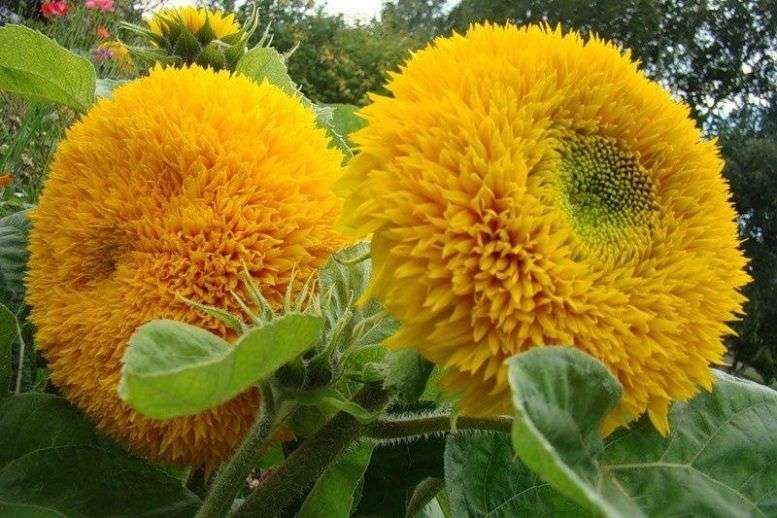

Sow directly into open ground or in boxes for seedlings. Growing seedlings only makes sense in regions with cold climates and short summers.
In most localities, sunflowers are successfully bred by sowing seeds directly into open ground. Sow no deeper than 3 centimeters. The distance between plants depends on the variety: large sunflowers are placed after 70 cm or more from each other, smaller ones - after 30-40 cm. Planting time begins in early May.
- weekly watering if the soil dries up;
- removal of weeds with simultaneous loosening.
The decorativeness of the flower bed can be maintained longer by cutting the flower baskets before the seeds are formed. The sunflower will have new buds and the flowering cycle will resume.
which will be described later, represents more than 100 varieties with special features. All varieties differ both in size and color, and in the nuances of cultivation.
Sunflowers are propagated by seeds, almost all varieties give abundant self-seeding. Collecting seed material is not difficult, it is much more difficult to protect them from birds.
To do this, wrap the inflorescences with gauze in one layer. You do not need to tie all the heads, wrap only those from which you plan to harvest seeds.
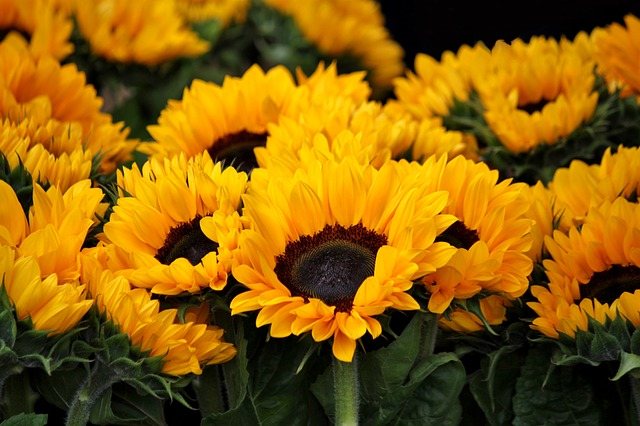

As soon as the seeds "ripen", and this can be determined by their darkening, cut off the heads. Seeds from seedlings should not be immediately pulled out, first they must be allowed to dry completely.
Planting material can be stored both in pure form and in the heads themselves. The germination capacity of decorative sunflowers lasts for a long time, up to 3-4 years.
You can also buy seeds for planting. The main thing in this business is to choose only trusted manufacturers. On average, a package weighing 40-50 g costs 20-30 rubles.
Seed preparation for planting is as follows:
- Selection. Throw out too small, damaged seeds. For the sake of interest, small seeds can be planted separately, but they are unlikely to sprout.
- Seed soaking. To do this, prepare an ash solution (1 tbsp. L. Wood ash, 0.5 l of water, leave for 24 hours). Soak a piece of cotton cloth or gauze in this solution and wrap the seeds there. Leave it for a day. As the fabric dries, dampen it with the solution.
After all this, you can start planting seeds in open ground.
Prepare the beds the day before planting. Dig up the soil to the depth of the shovel bayonet and level with a rake.Sunflower is an undemanding and unpretentious culture, therefore, fertilizers can not be applied to the soil.
The only thing is, if your site has loamy and clayey soil, you need to add sand there at the rate of ½ bucket per 1 sq. m. This will provide good drainage and high germination of shoots on such soil.
In order for the harvest of oilseed sunflower not to disappoint, you need to responsibly approach the choice of the site, select and prepare high-quality seeds, and also observe the planting rules, which are not complicated, but necessary to get a good harvest.
Sunflower grows on any soil, but gives a good harvest on slightly acidic loams, black soil, chestnut soils. Wetlands with high acidity, as well as sandstones for productive cultivation "for yield" are not suitable.
Sowing sunflowers after sugar beets and tomatoes is not recommended. In these areas, the soil contains a large amount of nitrogen, and the culture does not like it. This fact must be taken into account when applying fertilizers. A field previously sown with winter cereals, corn, cabbage is better suited.
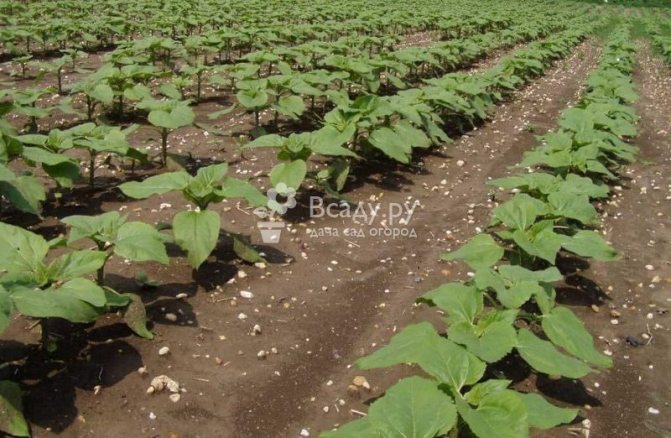

Sunflower quickly depletes the soil and cannot be grown in one place for two years in a row.
Also, keep in mind that after sunflower, the land requires restoration, and is not suitable for almost all garden crops. After it, the soil needs to be fertilized and planting spring grains, peas or beans - they will help to quickly restore the depleted soil. You can return to sowing sunflower in one area only after 7 years.
In the fall, phosphorus-potassium fertilizers are applied to the site: superphosphate, potassium sulfate. After that, the soil is deeply dug so that there is no subsoil and compacted soil areas at the root level.
Growing decorative sunflowers through seedlings
The soil for sowing annual sunflowers is standard, universal, nutritious and loose, but not with a slightly acidic, but neutral or slightly alkaline reaction. But containers need to be given more attention: sunflowers do not like transplanting, in order to avoid root injuries, it is better to sow them in individual cups or peat pots.
Sowing seeds is carried out depending on the desired planting time in the soil. Since the grown seedlings are not frost-resistant, planting can be carried out only in late May-June, and sowing of seeds - in late April or early May (20-25 days before planting in a permanent place). But the main thing that you need to focus on is the intensity of lighting, the ability to organize supplementary lighting.
Seeds are sown in 2-3 pieces in personal cups, removing weaker plants from emerging seedlings. Sunflower is germinated under glass or film, sowing is carried out to a depth of 1.5-2 cm into moist soil. Any temperature for germination is suitable within the limits of room indicators, but the lighting should be very bright.
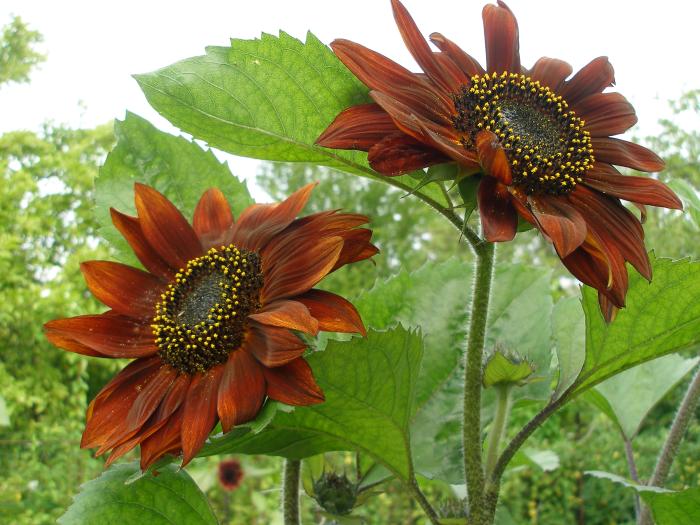

Growing a decorative sunflower.
Growing sunflower seedlings is not an easy task. With a lack of light, the plants turn out to be weak, the stems bend, the plant stretches and sometimes does not look like itself. For sunflowers, only a place on the southern windowsill or with supplementary lighting is suitable. Soil moisture should be consistently light. Top dressing is not carried out. Seedlings should be hardened as early as possible.
Read also: Grape seed oil instructions for use
Planting of decorative sunflowers grown through seedlings is possible only at the end of May or June, after the threat of return frost has disappeared. Plants are planted in the same way as they were sown in open soil, at a distance of 30-70 cm. The earth lump around the roots cannot be destroyed. Care for young seedlings is similar to care for young seedlings.
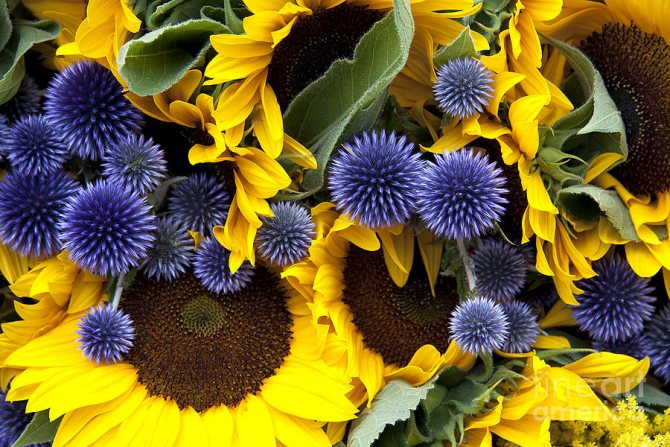

Decorative sunflower.
Every year, the flower beds and flower beds of my summer cottage are decorated with bright flowers, the sun of the decorative sunflower, my love for which began in childhood.Even a novice florist can grow such pretty plants. But there are still some subtleties of growing and caring for decorative sunflowers, so I'll tell you about them in this article.
Decorative sunflower
The decorative sunflower differs from the agricultural crop we are familiar with not only in the size of bright sunny flowers, but also in its purpose, the main goal of which is to create a unique flavor of the country (country) style in the garden.
By the way, the first sunflower seeds (Helianthus, from the Greek "helios" - "sun" and "anthos" - "flower") were brought from Mexico in 1510 by the participants of the fourth expedition of Christopher Columbus. Once in Europe, the sunflower has become a universal favorite, arousing genuine interest and admiration. For centuries, songs and poems have been composed about him, and his image is captured in the paintings of famous artists. So, it is the decorative sunflower that is depicted on the famous series of paintings by Van Gogh "Sunflowers".
Vincent Van Gogh. "Sunflowers". Photo from the site
Thanks to the continuous work of breeders, armed with modern methods of biotechnology and genetics, over 150 new varieties and hybrids of ornamental sunflower have been created. Every year, new products appear on the market, each of which is a new word in the selection of a species. Already withdrawn:
- touching miniature sunflowers capable of supporting several flowers on one stalk at the same time;
- charming terry sunflowers with a dense orange-brown heart;
- sunflowers that look like marigolds;
- and many decorative varieties with an extraordinary color - from cream to peach pink.
Diseases and pests
Despite the external power and invulnerability of plants, it should be borne in mind that insufficient care can provoke the occurrence of such diseases as:
- peronosporosis;
- black spot;
- gray spotting;
- alternaria;
- stem phomosis;
- ascochitis;
- rot.
As soon as signs of one of the listed diseases were found on one of the plants, it is necessary to spray the plantings using systemic fungicides.
For these purposes, perfect fit Apron and Cruiser.
Helianthus can infect and viral infections:
- mosaic;
- greening of inflorescences.
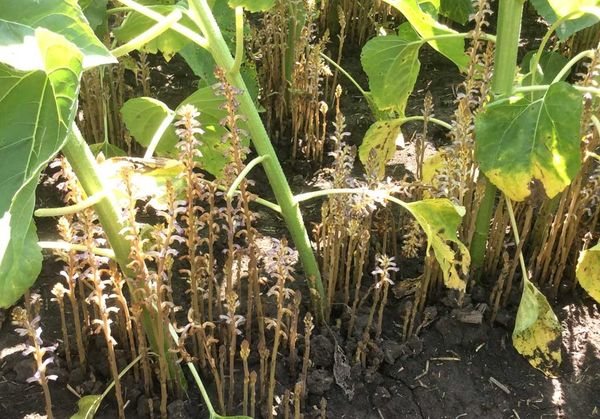

Sunflower broomrape
This disease is transmitted by insects. Also, it can seriously harm the development of a solar flower. broomrape (a parasitic flowering plant with a completely absent root system). Broomrape sprouts fully penetrate the roots of sunflowers and feed on them.
When growing helianthus, beware of the following pests:
- aphids;
- May beetle larvae;
- bedbugs;
- weevils;
- wireworms;
- meadow moths.
To destroy pests, it is advisable to use insecticidal and acaricidal preparations, which include Agravertine, Volley, Akarin.
Growing ornamental sunflower
Today sunflowers are grown all over the world: in Europe and Japan, North America, South Africa and Austria. By the way, it was in Austria, not far from Vienna, that the "Sunflower Park" was opened not so long ago, visitors of which can see over forty species of wild fellows, hundreds of modern oilseed varieties, as well as almost all decorative forms of sunflower that exist today.
Cultivation of decorative sunflowers The popularity of decorative sunflowers is due not only to the simplicity of their cultivation, but also to the variety of varieties. Depending on taste preferences, you can settle dwarfs (from 30 cm) or real giants (up to 5 m), single-stemmed or branched, small-flowered or large-flowered (from 5 to 20 cm) varieties in your flowerbed.
Ornamental sunflower seeds can be found in our catalog, which contains offers from many large garden online stores. Select sunflower seeds.
The colorful decorative sunflower is a close relative of the well-known oilseed sunflower.Both plants belong to the same species, and both are heavily used in garden design.
Rudbeckia hybrid
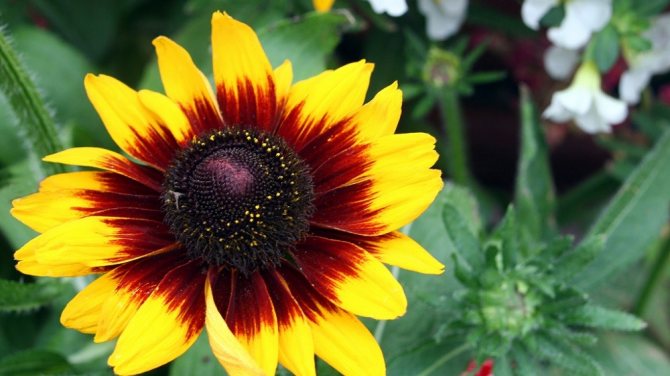

This plant with large inflorescences vaguely resembles a sunflower or chamomile (varieties Zelenoglazka, Terry gold, Autumn flowers, Amber, Marmalade and others). The ligulate petals of rudbeckia are very bright, yellow, fiery orange and red. The receptacle of the basket is convex, the tubular flowers are brown, purple and lilac. In different varieties, the size of the baskets varies from 9 to 17 cm.
In many varieties of hybrid rudbeckia, corolla petals are two-colored, with longitudinal or transverse striping.
Rudbeckia stems grow to a height of 50-250 cm. They are covered with elongated or oval leaves painted in a dense green color. The stems of the flower are firm and tough.
Learn how to grow perennial rudbeckia in your flower bed
Description and features
The sunflower belongs to the Aster family and combines a variety of species, most of which are decorative. Plants differ from each other, but they also contain common characteristics:
- high straight stems from 0.6 to 3 m;
- tough large leaves;
- inflorescences in the form of baskets with several rows of encircling petals;
- fruits are represented by compressed achenes.
Ornamental sunflower includes both annual and perennial varieties. The differences are in the height of the plants and the color of the petals, which can have different shades:
Jerusalem artichoke
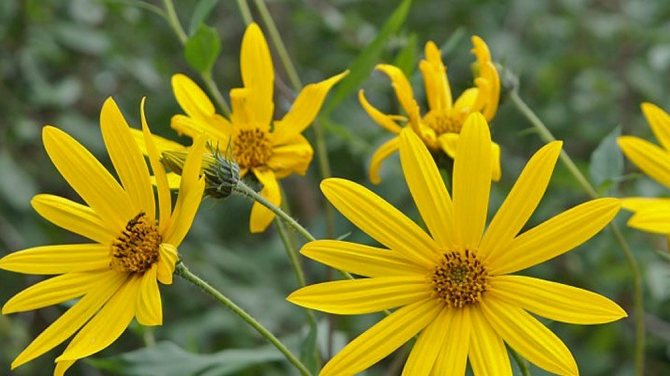

Jerusalem artichoke is a frost-resistant perennial crop grown in the middle lane and in the south. Some gardeners, when asked what the flower is called, will answer that it is an earthen pear. They eat tubers that taste like cabbage stump, turnip or turnip.
This plant blooms profusely with small bright yellow inflorescences. The ligulate flowers of Jerusalem artichoke are bright yellow, the tubular flowers are often dark brown. Baskets grow on thin long stems.
The diameter of Jerusalem artichoke inflorescences varies from 2 to 10 cm. The leaves of the plant are elongated, lanceolate. Jerusalem artichoke grows up to 2.5-4 meters in height.
Growing seedlings
Sunflowers can be sown directly into open ground, but it is preferable to use the seedling growing method. It is advisable to purchase seeds in stores and nurseries, although you can collect it yourself, but this method does not guarantee the preservation of the original characteristics of the plant.
Sowing dates
Sowing time directly depends on the timing of planting seedlings in open ground. For sustainable development in a permanent place, the plants should be 3-3.5 weeks old. On average, seeds are planted between late April and early May, but varietal requirements may shift this date.
Soil requirement
The soil for growing ornamental sunflower requires loose and very lightweight. The best option would be sandy loam soils. The land must be prepared for planting at least 24 hours in advance. The site should be dug up, dense clay soil or loam should be diluted with sand.
High indicators of decorativeness are associated with moderate moisture and soil nutrition. And the presence of high acidity and salinity has a negative effect on the appearance of sunflowers.
Landing dates
Ornamental sunflower varieties are not particularly resistant to frost, so it is recommended to plant seedlings after warm weather has established. Plants are usually planted starting in the second half of May. With seedless cultivation in the southern regions, seeds are sown in late March or early April, and starting from middle latitudes and further north, the period shifts to the end of May.
Sowing sunflower seeds in open ground can be carried out not only in spring, but also in autumn. However, in this case, seedlings appear in spring only in warm climates with mild snowy winters.
Landing scheme
The distance between individual seedlings depends on the sunflower variety. Low-growing plants are located no closer than 0.3 m from each other.Tall ones need even more space, and it is optimal to distance the specimens by 0.7 m. No more than 3 shoots can be placed in each hole, but a tight planting leads to a decrease in the size of the flowers.
Read also: Ash leaf leaf description
Sunflowers do not have high maintenance requirements. The most important condition is the abundance of sunlight; plants should not be placed even in partial shade. Strong stems are not afraid of the wind, but undersized varieties are best planted in sheltered places.
Watering
Flowers need abundant regular watering. It is impossible to allow both the drying of the soil and the stagnation of moisture at the roots. Plants are watered weekly, and in the sultry heat - daily. The sunflower needs water especially strongly during the period of leaf formation, as well as during the appearance of buds and during flowering.
Loosening and weeding
The soil must be loosened after each watering, as well as after rain. This stimulates the vegetation of the plant and saturates the roots with moisture and oxygen. At the same time, weeds are removed, which takes food from the sunflower and shades the seedlings.
Top dressing
The decorative qualities of sunflowers are enhanced by the presence of nutrients in the soil. A month after the appearance of the first shoots, the plants can be fed with nitrogen fertilizers; during flowering, complex mineral fertilizing or phosphorus-potassium mixtures can be used.
Pests and diseases
Ornamental sunflower can be affected by insects and bacterial diseases. Dangerous infections:
- Downy mildew. Pests and high humidity stimulate the development of the disease, from which a white bloom appears at the bottom of the leaf. The diseased parts of the plant must be cut off, and the plantings must be treated with fungicides or soapy water with the addition of copper sulfate.
- Brown spotting. The disease causes the appearance of dark drying spots on the leaves in conditions of high temperature and humidity. For treatment, drugs "Vectra" or "Strobi" are used.
- Rust. The fungus forms orange pustules filled with spores; you can get rid of the disease with the help of fungicides.
Sunflower moth
Caterpillars of a sunflower moth or moth infect plant leaves. You can get rid of insects with the help of insecticides, but there is no prophylaxis against these pests, in addition to weeding.
Sunflower barbel
These beetles lay eggs in the stems of the sunflower, and the larvae destroy its structure. Proper care and removal of weeds will protect plantings, and chemicals will kill insects.
Sunflower thornbearer
The pest lays eggs in the leaf axils, and the larvae quickly penetrate into the stem. Deep digging of soil and removal of dry shoots is a good prophylaxis of the fight against shyponoska. Plants can be treated with "Vantex", "Fufanon" or similar products.
Cutting off faded inflorescences
Sunflowers do not always bloom at the same time; for the re-emergence of baskets, it is recommended to cut off the previous ones immediately after the loss of attractiveness. This procedure will stimulate the plant to re-develop flowers. In autumn, the shoots of perennial varieties are cut off completely.
The genus sunflower includes at least 50 species of plants with decorative characteristics. The most common:
- annual or oilseed;
- tuberous or Jerusalem artichoke;
- ten-petal;
- Maximilian;
- holly;
- red-stemmed;
- bright-flowered.
Tuberous
The main difference between this species is the formation of tubers in the underground part of the plant. External characteristics:
- shoot height up to 3 m;
- the stem is poorly covered with leaves;
- small baskets from 2 to 6 cm;
- petals are golden yellow.
Ten-person
A common decorative appearance is characterized by:
- plant height 1.5 m;
- dark green leaves;
- flowering from the second half of August to late autumn;
- simple or double inflorescences;
- petals are golden or yellow-lemon.
Chrysanthemums
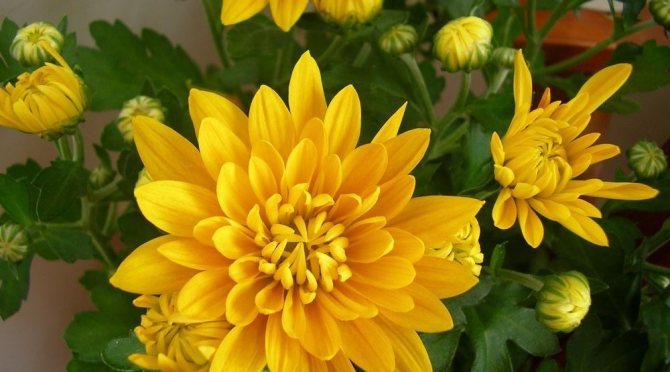

All breeding chrysanthemums have single-row or double inflorescences of various colors and sizes. These plants are resistant to cold weather and are pleasing to the eye until frost. Chrysanthemums are planted in flower beds behind low-growing flowering plants.
There are dozens of varieties whose baskets look like little sunflowers. These are chrysanthemums Maiden (Golden Bol), Terry (yellow and white), Svemba kars, Mishal and a number of others. The tubular flowers of the basket are often black, yellow or green.
Most varieties of this flower have bare or pubescent stems, jagged green leaves. The height of the peduncle stems reaches 40-60 cm.
Popular varieties
There are a lot of varieties of decorative sunflower, as well as hybrids. Plants vary according to size, climatic requirements and external characteristics.
All varieties, both pure and hybrids, have a delicate, pleasant smell, attract bees and are honey plants.
Vanilla ice
- used for bouquets;
- simple basket shape;
- vanilla petal color.
Teddy bear
External data of the plant:
- shoots up to 1 m;
- double flowers about 22 cm across;
- bright yellow petals;
- long flowering.
Red Sun
Characteristic features of a sunflower:
- height no more than 2 m;
- long flowering;
- red-brown color of the petals.
Moulin Rouge
Flowers of this variety are different:
- the center of the petals is burgundy red;
- the edge is light;
- the core is dark.
- height about 5 m;
- shoots are prone to kink in the wind;
- use as a hedge.
Procut Red Lemon Bicolor
The appearance of flowers of this variety is characterized by:
- black core;
- inside the petals are red;
- the edge of the flower turns yellow.
Moonlight
- height up to 1 m;
- inflorescences are simple;
- petals are lemon yellow.
Giant Single
Special features of these sunflowers:
- height 2 m;
- large baskets;
- simple form of inflorescences;
- petals are golden.
Italian White
External differences of the variety:
- light, almost white petals;
- dark center;
- simple basket shape;
- high growth.
Cherry rose
The foreign variety is characterized by:
- fast growth rates;
- the center is almost black;
- the middle of the petals is red-cherry;
- edges are light yellow;
- no pollen.
Florenza
Features of these sunflowers:
- used in bouquets;
- the central half of the petals is burgundy;
- the edges of the flowers are yellow.
Black Magic F1
- the height of the shoots is 1.2 m;
- rich maroon color of the baskets;
- use in bouquets.
Gatsania
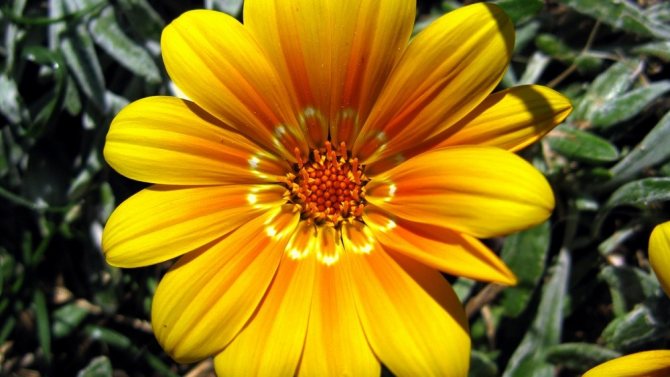

Gatsania is a small annual 25-30 cm high. The inflorescences of several varieties of gatsania vaguely resemble sunflower baskets. Among them are the varieties Talent yellow, Gatsania red-yellow, Triada.
The lingual petals of the basket are colored yellow, orange-yellow, red, creating a ring pattern. In some varieties, the pattern is longitudinal, in the form of stripes. The tubular gazania flowers are yellow. One bush grows up to 35 inflorescences with a diameter of 5-9 cm.
The stem of the gatsania is short, and in some varieties it is absent altogether. There is a nap on the undersides of the sheet plates, which helps to keep moisture in and protects from the cold.
Meet the beautiful gacinia in the full plant review.
Use in garden design
In the decoration of garden plots, both single plantings of a decorative sunflower and a combination with other flowers are widely used. The plant decorates flower beds and hedges, creates a bright accent and forms a rustic interior.
Flower beds
When forming a joint flower bed, it is worth planting yellow sunflowers in combination with blue, purple or white flowers. Large inflorescences are in good harmony with chrysanthemums, lavender, small wildflowers, white liatrix and delphiniums.
Decorating fences, compost heaps, buildings
Low-growing sunflowers can be planted along the edge of garden paths and at the edge of hedges. High grades look good against the background of blank walls of buildings. Lush plants can hide unattractive compost heaps from view.Sunflowers also make a good backdrop for rustic garden designs.
Bouquet, cut
Not too large bright baskets of sunflowers are used by florists to create original bouquets. The inflorescences create a good harmony with roses, gladioli, asters and chrysanthemums. Sunflowers keep their freshness for a long time and do not overpower other flowers.
Tips for gardeners
When, where and how to plant a sunflower, each gardener decides for himself. Some helpful tips:
- Select seeds carefully for planting. This is a cross-pollinated crop, so it is not recommended to use seeds of a variety that has been grown on the site for more than two years. There will be many empty baskets or baskets with small fruits.
- The greater the distance between the plants, the larger the seeds will be. This is especially true for giant plants.
- A long interval between sowing seeds and seedlings may indicate that they have been damaged by rodents or eaten by birds. Re-seeding can lead to lower yields.
- To ensure the friendly germination of seeds, some preparation is carried out. They are soaked in water, wrapped in gauze or other cloth at a temperature of 200 C. As soon as the first shoots appear (usually after 2-3 days), they are planted in the ground.
- The sunflower grows well in the company of beets and potatoes. It is sown between rows of vegetables.
- You should not grow a crop for more than three years in a row in the same place. Plants literally suck nutrients out of the soil. The break will allow the ground to rest and get rid of pests.
- Sunflower is a light-loving plant. You cannot plant it densely - the baskets will be small.
- A simple method will help in choosing quality seeds. In a 5% saline solution, seeds suitable for planting will go to the bottom in 5-10 minutes, and they should be taken away.
Asters
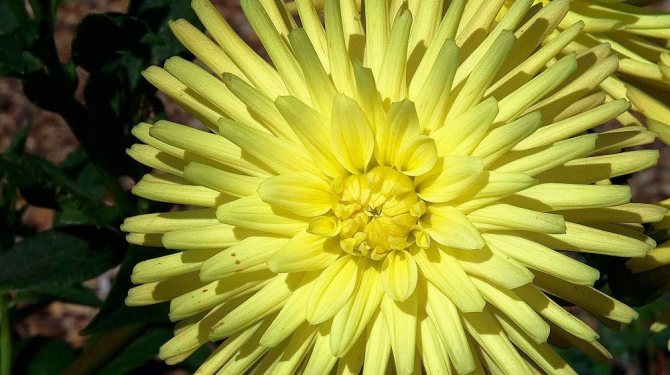

Asters are not terry varieties in the structure of inflorescences similar to a sunflower. This is Andrella super, Matsumoto, Rainbow, Alpine Astra.
Aster alpine ligulate flowers are white or yellowish, they are also pink, red, lilac and purple. The receptacle of the baskets of this variety is raised, but slightly recessed towards the center. The tubular flowers have yellow petals. In the center of the calyx, flowers are undeveloped, they are green in color. The diameter of the inflorescences-baskets is 4-6 cm.
Astra Andrella is super similar to the variety described above, but the inflorescence receptacle is flatter here. The color of Andrella's reed flowers is Super pink, purple, white, yellowish, the tubular flowers are yellow. The diameter of the basket is 9-10 cm.
In total, there are much more flowers that look like a sunflower. You have only met the most common plants.
Application
- Flowerbeds, borders.
- Decoration of fences, compost heaps, buildings.
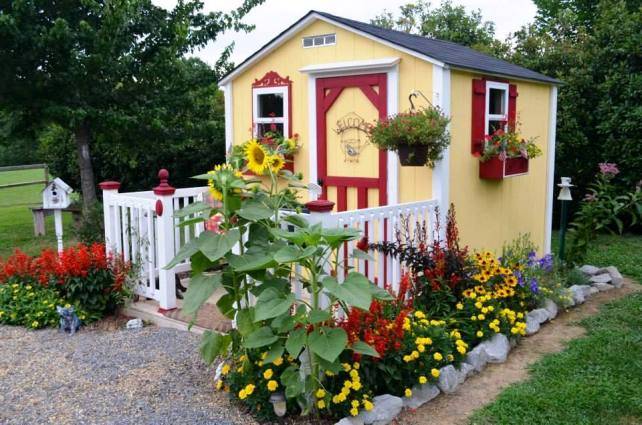

- Bouquet, cut. True, the flowers retain their freshness for no more than a day, but the appearance of such bouquets cannot be compared with any others.
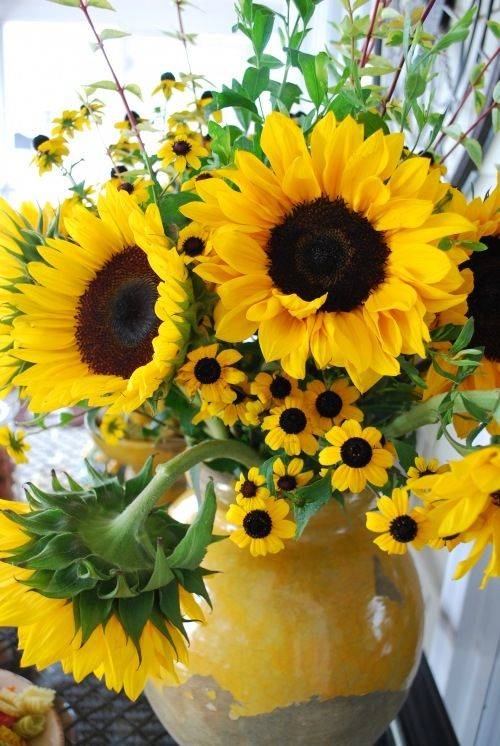

Reproduction of culture
Decorative garlic - planting and care
Perennial species of helianthus reproduce by cuttings. You need to cut a decorative sunflower in spring or autumn. Perennial varieties are also propagated by dividing the bush - this rejuvenates the plant and increases the splendor of flowering. "Divide" the sunflower three years after planting.
In the climatic conditions of Central Russia, sunflower is often grown as an annual plant. The most common way to breed sunflowers is by sowing seeds. There are a lot of varieties for breeding this plant. The most popular: sunflower Bear cub, domestic variety Krasno Solnyshko (red sunflower).
It is interesting: Planting and caring for calistegia in the open field, cultivation features
Growing from sunflower seeds Bear cub begins with soaking the planting material. Soak a cloth with a solution of wood ash (1 liter of warm water and 2 tablespoons of ash) and wrap the seeds in it.
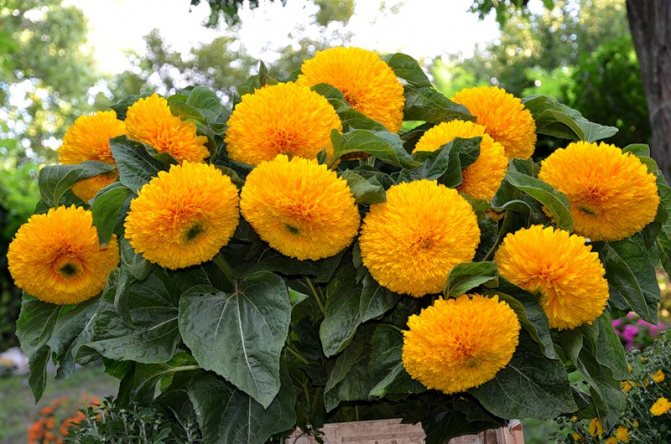

Dig holes 6 cm deep, pour a few seeds into them.The distance between plantings should be up to 0.5 m, for large varieties about 0.7 m. The distance between the rows of crops should be up to 0.8 m. The first shoots will appear in 10 days. To get a constantly blooming flower bed, the seeds must be sown at weekly intervals.
The ideal time for planting outdoors is early May. Gardeners also practice earlier sowing - April. The temperature should be stable at around +10 C °, then the seedlings will appear. It will take about 80 days between sowing the seeds and the appearance of the first flowers.
The sunflower is also bred by the seedling method. For this, 2-3 seeds are planted in small pots. This must be done a month before the florist decides to plant them in open ground. Seedlings should be placed on a well-lit window, watered periodically, but not excessively.
Small sunflowers are planted in open ground at an established temperature of +12 ° C.
Note! Reproduction of helianthus by seeds is the simplest and most effective way, the seeds remain viable for up to 5 years.
Many amateurs practice growing decorative sunflowers at home; dwarf varieties are suitable for these purposes. The pot should be chosen based on the variety; for low varieties, a container with a diameter of about 40 cm will suffice. Before planting, the container needs disinfection to avoid diseases of future plants.
At the bottom of the pot, drainage must be done; pebbles or polystyrene are suitable for this. Pour special soil on top of the drainage layer, without adding about 2 cm to the edge. Seedlings will appear in a week, after which the containers are placed on the window. Even at home, you can grow a sunflower Bear cub.
General information about the plant
The seeds of helianthus (this is how the sunflower is called in Greek - Helianthus - the sun flower) came to Europe with the Mexican expedition of Christopher Columbus. Of course, the giant flower for a time became the object of universal admiration, like almost any overseas curiosity. The interest turned out to be quite persistent: a flower with petals like a flame was immortalized in poetry and paintings.
Modern breeders really did not ignore the culture. Today there are more than 150 varieties of sunflower, and given that breeding science does not stand still, new varieties with new qualities appear. For example, today you can buy:
- Adorable low-growing sunflowers with several huge flowers on one stem.
- Terry sunflowers that look like giant dahlias.
The height varies from 30 cm to 5 meters, the size of the inflorescences is from 5 to 50 cm. One stem can have from 1 to 10 flowers. The petals are different - long and thin, short and thick, curved, wavy, twisted. The petals can contrast with the tubular flowers of the center, or be tone-on-tone.
Flowering usually begins in the second half of summer and continues until late autumn.
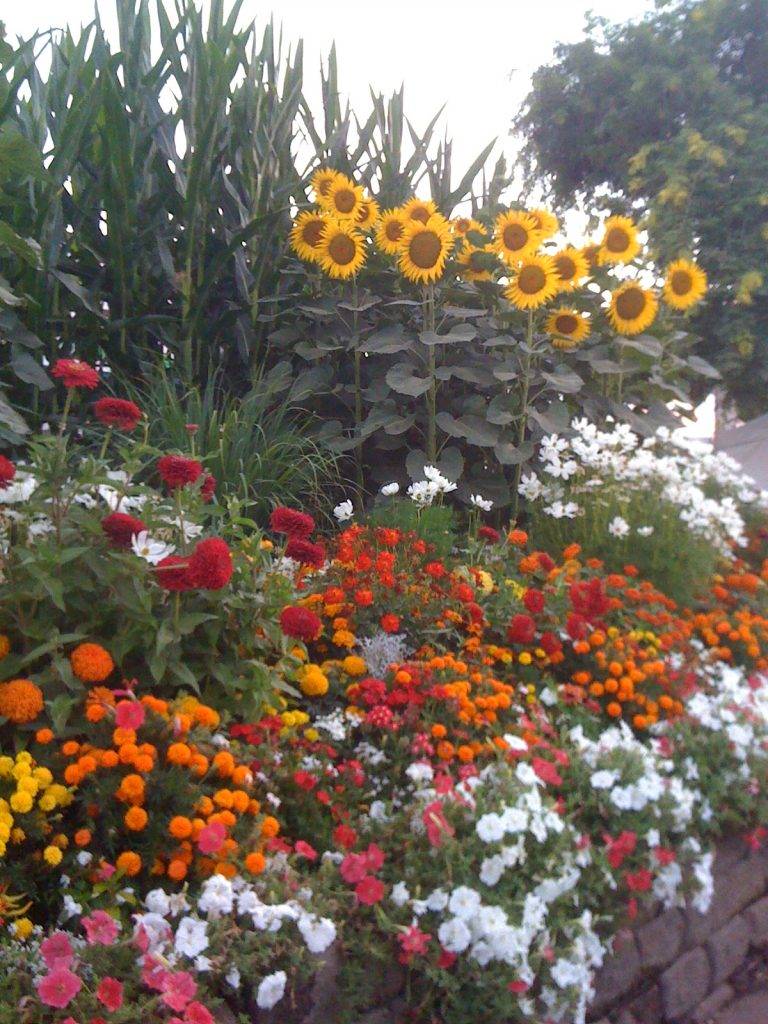

What do these flowers look like?
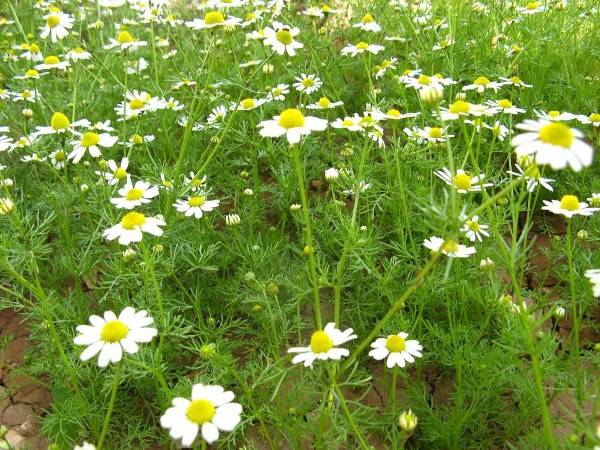

Pharmacy chamomile
Chamomile and most plants similar to them belong to the Aster family. Its representatives are easy to identify by:
- herbaceous stem;
- elongated petals;
- a basket framed with petals;
- weak aroma.
The most common type of chamomile is pharmacy... In flower beds, most often there is a large or decorative one. Asters, some varieties of chrysanthemums and gatsanias also have large inflorescences.
Multicolored daisies
The first sign by which you can distinguish them is the color of the petals. In chamomile, pharmaceutical or decorative, they are white. There are similar flowers with different shades of petals..
Blue
Blue color indicates that Asters or Cineraria have grown... In the latter, the petals are sometimes colored half white, which creates a pleasant decorative effect.
Colored
Colored daisies, which have petals in different colors and shades, called Anemone Blenda or Anemone Crown... Echinacea varieties have a similar color.
Yellow
Doronicum (goat) is most often confused with yellow... You can also find Pyrethrum with lemon-colored petals, this variety is very similar to Chrysanthemum due to the double petals and the shape of a small shrub.
Purple and lilac
Asters, Osteospermum with purple petals look very beautiful in borders and bouquets... This also includes lilac daisies, the brightness and type of shades varies depending on the variety of a particular type of plant.
Care.
Taking care of a sunny flower is very simple. All that is required for this plant is timely, moderate watering, after which it is necessary to loosen the soil around the bushes. In addition, it is necessary to regularly remove sleepy plants, as well as periodically make mineral fertilizing - no more than 1 time per month, that is, about 3 times for the entire season.
When the plant begins to bloom, around July-August (depending on the time and method of planting), organic fertilizing can also be applied. After flowering is complete, the seeds are collected and stored for planting for the next year. In late autumn, decorative sunflowers are destroyed by their roots, the earth is dug up and fertilized. After 2-3 years, it is recommended to change the site for planting Gelianthus.
Landing.
There will be no difficulties in planting a decorative sunflower - this flower grows in almost any soil, but if you create ideal conditions for it, it will bloom more beautifully and longer. The name of the flower, sunflower, gives a hint for choosing a site for planting - it needs a sunny, open place.
Planting time depends on the characteristics of the climate in which it will grow. It is important that the soil is already well warmed up, and the risk of frost has passed. Helianthus is a thermophilic flower, so it is best to plant it in early or mid-May.
Most often, seeds are planted in prepared holes - immediately into open ground. But, you can pre-prepare the seedlings - this way you can get an earlier flowering. But, this method has a drawback - the plant does not adapt well after transplantation.
Elecampane


Elecampane is a medicinal plant that is used in herbal medicine. It is a herbaceous bush with long stems and broad, toothed leaves. One stem grows 3-6 inflorescences and several leaves. The height of the bush, depending on the variety, is 30-70 cm, the diameter of the basket is 4-15 cm.
Inflorescences of elecampane are orange, yellow, light yellow, tubular and ligulate flowers are painted in the same or different colors. The ligulate petals are narrow and long; they form one or more rows.
This plant is planted among rocks in rockeries and on alpine hills.
Venidium (Arctotis)
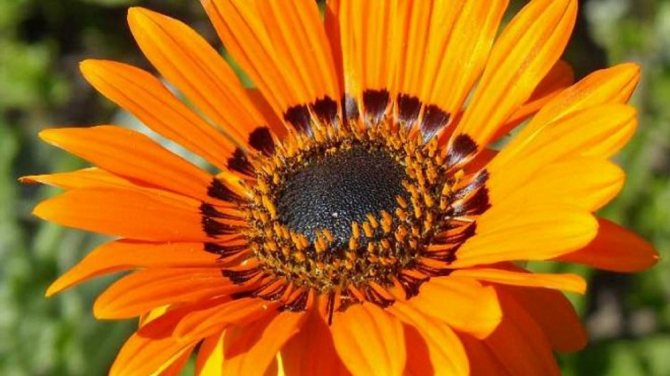

Venidium inflorescences are painted in a variety of colors. The varieties Orange Prince, Amaretto, Marigold Venidium are similar to the sunflower.
Venidium Orange Prince produces large baskets up to 10-12 cm in diameter with bright, orange-yellow and orange reed flowers. The diameter of the inflorescence of Venidium marigold is 3.5-4 cm.
The ligulate flowers of Venidium have the shape of a strongly elongated oval. The tubular flowers are black, dark brown. Plant height varies from 45 to 70 cm, its bushes are wide and branched. The plant blooms from June to September, it is planted in multi-level flower beds, combined with other aster flowers.
Composition and properties
The leaves, stems, marginal flowers of sunflower are rich in: flavonoids, sterols, anthocyanins, carotenoids, saponins, choline and phenol carboxylic acids.
Plant seeds contain: carotenoids, tannins, sterols, fatty oil and fatty acids, proteins, carbohydrates, vitamins E and PP, lecithin and phospholipids. Sunflower root is rich in potassium salts and alkaline alkaloids. Unrefined sunflower oil contains vitamins A, E, F and D. Due to its composition, annual sunflower has: anti-inflammatory, astringent, expectorant, diuretic, choleretic and laxative effects.Also, this plant regulates salt metabolism. In folk medicine, sunflower is recommended for:
- flu;
- malaria;
- cough;
- catarrh of the upper respiratory tract;
- bronchial spasms;
- thyroid disease;
- atherosclerosis;
- diseases of the heart muscle;
- poor appetite;
- colic in the stomach and intestines;
- urine and gallstone diseases;
- hepatitis;
- diseases of the biliary tract;
- arthritis, polyarthritis, osteochondrosis and other diseases associated with salt deposition;
- neuralgia;
- oncology;
- diseases of the genitourinary system;
- pemphigus vulgaris;
- diabetic ulcers;
- burns, neurodermatitis, eczema.
Outcome
Today, ornamental sunflowers are often grown to decorate the garden. Unpretentious plants allow you to create extraordinary comfort on the site. Designers use sunflower to create garden and home decorations - a simple, clear flower shape will suit country or Provence style, complementing your familiar environment with sunlight.
Oh, there are a lot of them. What happens and not too similar, but if you pick up a shade, then even very - some varieties of calendula (albeit remotely, because the plant itself does not look very similar that the flowers are very even ...), some yellow gerberas.
Now for the fun part:
1 - Jerusalem artichoke. They can often be seen in vegetable gardens, and in landfills. And the tubers are delicious.
2 - Elecampane. A useful plant (it grows like a weed in our country, already tired, it sprouts everywhere, but was planted as a medicinal rarity)
3 - Sanvitalia.
4 - Hybrid rudbeckia
5 - Finally, a decorative sunflower. We planted Mishka at home.
Sanvitalia
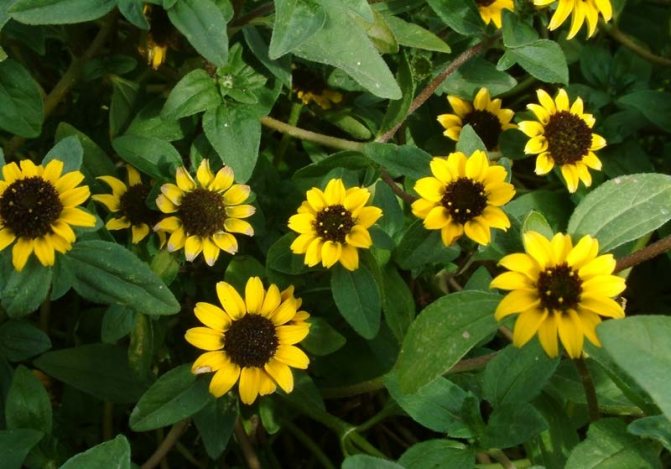

This annual is characterized by abundant flowering, sanitary bushes from July to October are strewn with dozens of small flowers. The color almost completely covers the foliage. Sanvitalia's baskets are small, their diameter ranges from 1.5 to 2.5 cm.
The marginal (ligulate) petals of the inflorescences are rich yellow, the receptacle of the basket is convex. The tubular flowers of the sanvitalia are black with a purple or brown tint. There are varieties of sanvitalia with a green heart, white or orange corolla.
The branched stems of the flower grow up to 30-60 cm, they bend, giving the bush a spherical shape. The varieties Gold Braid, Sunshine, and the Yellow Sea are similar to small sunflowers.
Diseases.
Helianthus is not resistant to disease. It is often affected by downy mildew, as well as brown spot and rust. These problems can be dealt with with a fungicide solution, and the affected areas can be removed.
Prevention of such diseases consists in moderate watering, control of soil moisture and timely destruction of pests - carriers of infections. As for the pests, most often the sunflower is attacked by the pinch-beetle, barbel and moth. You can deal with them with chemical insecticides.
The decorative sunflower looks very cozy in any area, and with its bright bloom complements various compositions. By observing the minimum care rules, you can grow healthy and beautiful plants.
Decorative sunflower varieties with photo
Sunflower Decorative Raspberry Queen
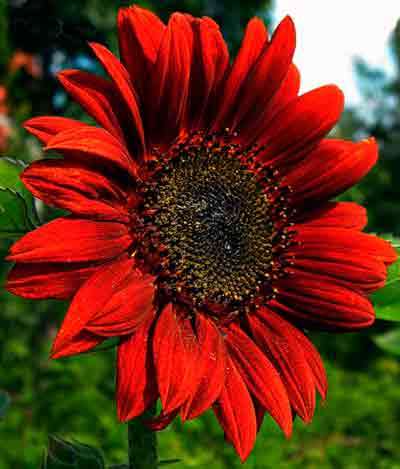

Sunflower Decorative Raspberry Queen is an interesting variety of decorative sunflower. It was said to be a new luxury giant variety. It reaches a height of 1.5-1.8 m and has dense, large velvety inflorescences with a dark brown center and petals of a noble, intense crimson color.
I bought a bag of this variety from Poisk.
I was expecting sunflowers with approximately the same colors as in the first photo.
As a result, the flowers of the decorative sunflower turned out to be completely different.
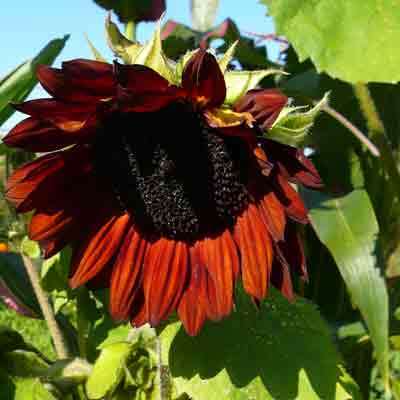

They are less decorative, but they have a number of advantages. The plant forms four caps at the top, directed in different directions. They bloom alternately, one sunflower flower fades, another is formed on the side. Sometimes it begins to form without waiting for the previous one to fade. I immediately removed the fading baskets. When the upper ones had faded, new flower stalks emerged from the sinuses.So they bloomed until they were beaten by severe frosts at the end of October. We endured small frosts calmly, only they stood gloomy until the sun came out.
Decorative sunflower Teddy bear
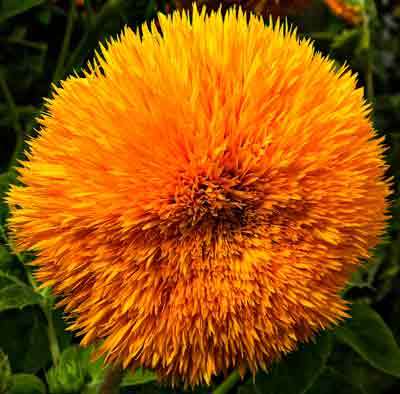

Sunflower Ornamental Bear cub is an annual plant up to 40 cm high. Stems are erect, double flowers, bright yellow, up to 15 cm in diameter. The bush is very compact and low. Flowering is very abundant, and until late autumn. It is recommended to sow seeds in April-May directly in open ground. Many flower growers in central Russia in mid-April are planted on seedlings in cups, and only when the threat of frost has passed, they are planted in the ground in a permanent place. She tolerates the transplant well.
A very interesting, rather undersized variety, with fluffy, cute, touching flowers. It grows well in partial shade, although it likes a sunny location.
Looks good in flower beds, does not drown out other plants. However, the flower bed requires a lot of space.
Sunflower Decorative Teddy Bear or Teddy Bear
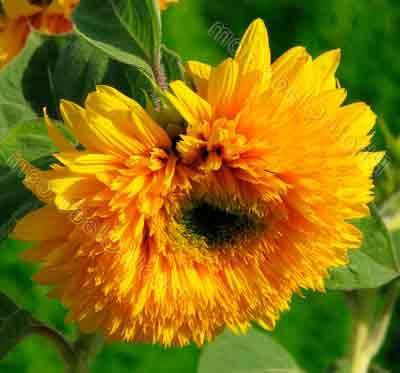

One of the most beautiful varieties of Teddy Bear or Teddy Bear. Similar to the variety Bear cub, short, no more than a meter in height, with double bright yellow flowers up to 22 cm in diameter, reminiscent of a plush toy. It blooms well even under not very favorable climatic and weather conditions. Flowering in mid-summer lasts until autumn.
Sunflower decorative Red Sun
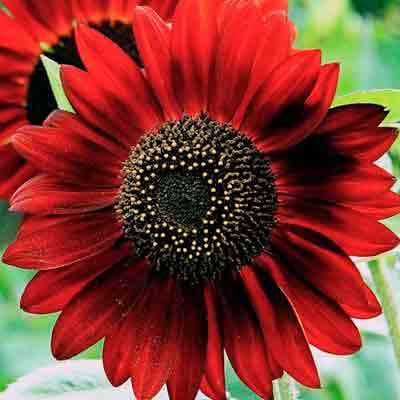

The decorative sunflower Red Sun is a bit like the Crimson Queen. A very interesting variety with red-brown flowers, reaching a height of up to 2 m.
Decorative sunflower Vanilla Ice
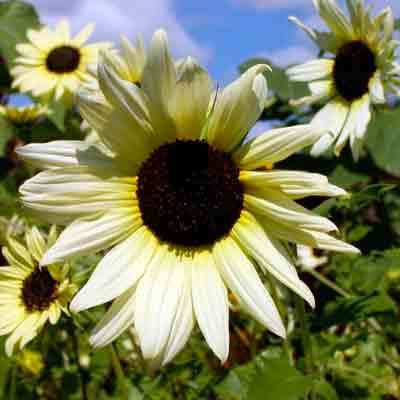

Decorative sunflower Vanilla Ice
This variety was bred by foreign breeders. It has charming, pale yellow non-double petals, which are contrasted with a dark core.
Decorative sunflower Moulin Rouge
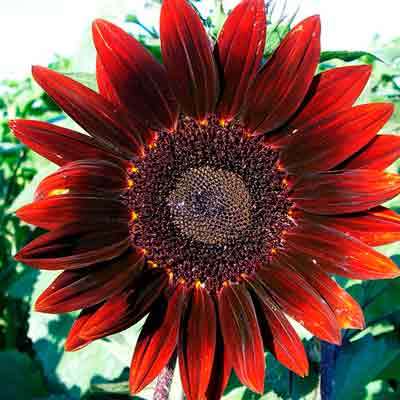

The decorative sunflower Moulin Rouge is also a variety of foreign selection. In a sunflower of this variety, the flower is painted in a rich carmine-red color, the petals gradually change color along the length, they are lighter at the edges, and darker towards the core.
Decorative sunflower ProCut Red Lemon BiColor
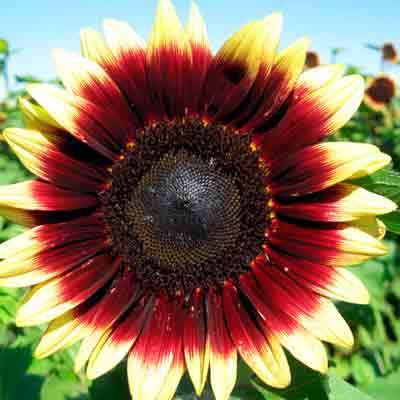

And this is also a wonderful product of foreign breeders - decorative sunflower ProCut Red Lemon BiColor
This is an amazing two-tone sunflower: the inner half of the petal is colored dark red, and the outer half is light yellow.
The core of the flower is black.
Sunflower decorative Kong
There is a cultivar that reaches a height of 5 meters! This is a decorative Kong sunflower. It is one of the tallest sunflowers and has thick stems and wide leaves. An excellent solution for creating a decorative fence. An entire jungle grows in which you can get lost.
Sunflower - the flower of the sun, its seeds were brought to Europe from America in the 15th century. Sunflower came to Russia under Peter I and for a long time it was grown as an ornamental crop, only after a while one peasant got a delicious golden oil from sunflower seeds through a hand press. Now sunflower is grown as an oilseed crop on an industrial scale.
Today, the sunflower is back in vogue, it is grown as decorative annual flowers all over the world and every year more and more varieties and garden forms appear.
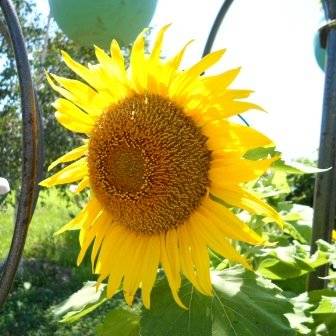

The Latin name for sunflower is helianthus (Helinthus)as well as Russian it comes from the Greek words helios - "sun" and anthos - "flower".
Rod Helianthus belongs to the family of Asteraceae or Asteraceae and includes about 50 plant species, native to the American continent.
Both in agriculture and in floriculture, one type is mainly used - this annual sunflower (Helianthus annuus) from which many varieties have been created, differing in both the size of the plants and the size, shape, color and number of inflorescences on one plant.
Wild sunflower is a plant with a strong, branched stem, about 1 meter high, on which many small inflorescences up to 8 cm in diameter appear, similar to small suns.
Sunflower inflorescences are a basket, inside of which there are small tubular flowers, they can be yellow or chestnut in color, and along the edge of the basket there are large lingual flowers, usually yellow, they give the flower a crown frame. After flowering, faceted achenes ripen in a sunflower basket, their germination remains up to 2-3 years.
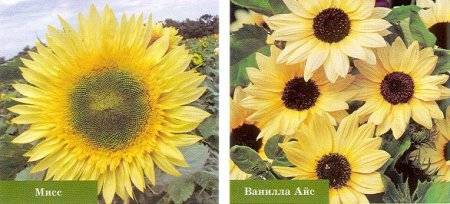

The highest ornamental sunflower varieties grow up to 3-4 meters in height and bear the corresponding names "Russian giant" or "Russian size". They are suitable for creating tall flowering hedges and for hiding unsightly areas in the garden.
Low-growing varieties of helianthus, 40-50 cm high, are more attractive for flower growers. They are well suited for creating flower arrangements, as well as for growing in pots and small containers.
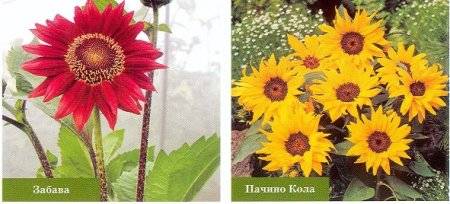

Sunflower varieties with unusual densely double, pompom inflorescences of a bright yellow color are very popular; there are also red, brown, bright yellow with a dark center.
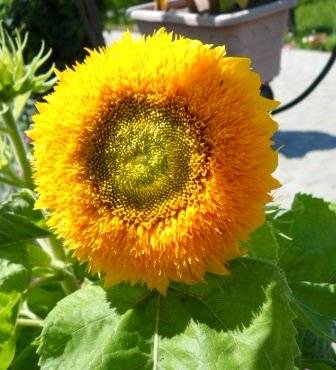

Sunflower flowers with a two-color petal color look beautiful, when their main part has a beautiful red-brown color, and a bright yellow edging goes along the edges.
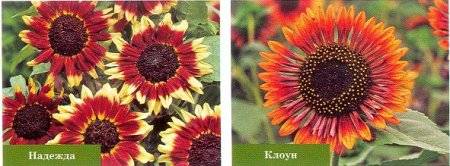

The color of modern varieties of heliantos is very diverse, if your sunflower flower is associated with the sun, then now you can find flowers with green shades, white, cream, maroon to almost black.
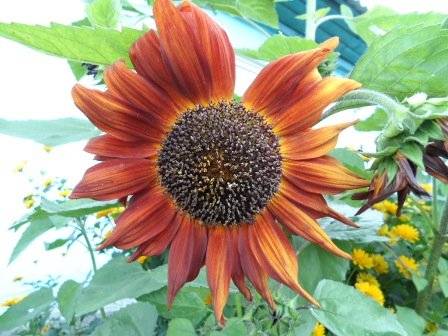

Choose as many varieties of ornamental helianthus as possible, differing in stem height, size, shape and color of inflorescences, to compose a varied floral arrangement.
Grow an ornamental sunflower even a novice florist can on his flower garden, the main thing is to take into account several conditions when planting and caring for this plant.
It is not for nothing that the sunflower is called the "flower of the sun", because it develops well only in an open sunny place and the inflorescences of the plants will be large, brightly colored.
Annual sunflower is a thermophilic crop, therefore it does not tolerate frost. This annual flower is propagated by sowing seeds in mid-May. Seeds are sown in holes of 1-2 pieces, depending on the size of the plant, at a distance of up to 40-50 cm.
To get an earlier flowering, sunflowers are grown through seedlings. The seeds are sown in small pots in April, from which at the end of May the young plants are transferred into the ground to a permanent place, trying not to damage the root system, since the sunflower does not tolerate transplanting well.
Miniature low-growing varieties of helianthus are often grown as a pot culture, plants up to 35-40 cm in height are sown in 1.5-2 liter containers, with a nutrient mixture. Pots with blooming sunflowers in summer can be arranged in any arrangement.
The soil for growing sunflower is best loose and nutritious. This plant actively draws out many nutrients from the ground, therefore, the flowers are fed two or three times a season with mineral fertilizers; it is not recommended to use fresh manure as fertilizer.
The sunflower is watered sparingly, as it does not like excessive moisture. After watering, the soil around the plants should be loosened. Weed and protect against diseases and pests as needed.
Sunflower blooms in July - early August and the inflorescences of the basket will decorate the plants until the very frost, and in the fall the ripe seeds can be collected for sowing next year or used for food.
How to choose a flower that looks like a chamomile?
Among the listed variety, every camomile lover will find a suitable option. The choice depends on the properties of the varieties, color preferences and plant size. Chamomile flowers come in different colors, heights and even types (grass, shrubs)... They are selected for any ensemble in a flower bed and they will last more than one year, delighting with bright colors and long flowering.
Quote post by Stlani
Sun flower. Decorative sunflower. Helianthus. Helianthus.
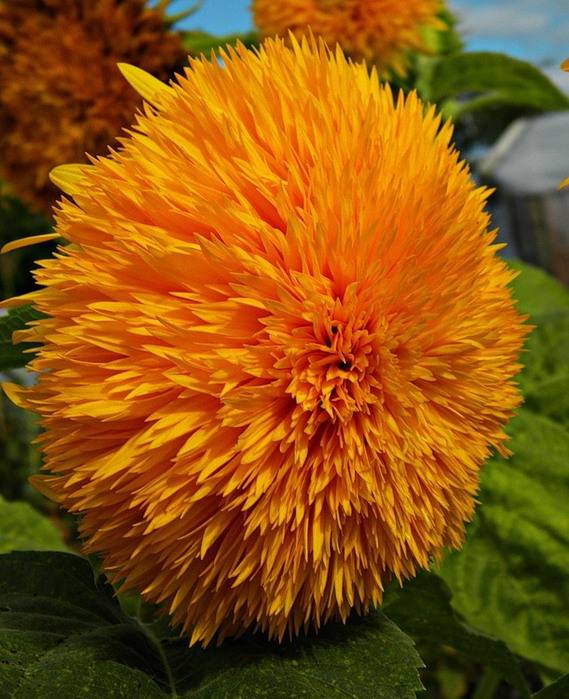

Who among us does not like to indulge in delicious sunflower seeds on vacation. And few know the history of sunflower.
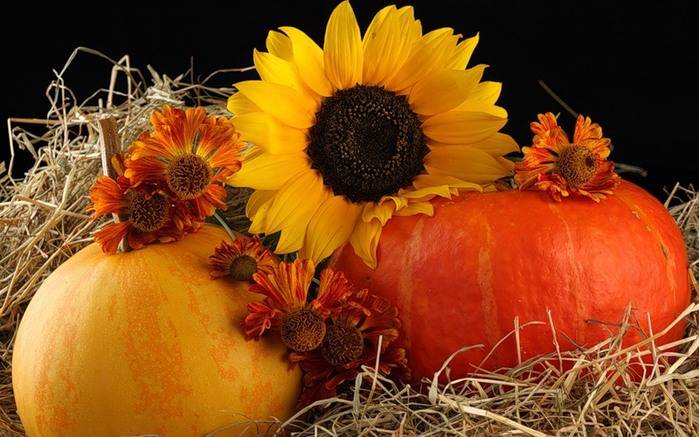

Its value as an oilseed crop was opened to the whole world in Russia, where it was introduced thanks to Peter I. At first, sunflower was grown as an ornamental plant, later for the pleasure of eating seeds, and only at the end of the 18th century. the first timid attempts to obtain oil from seeds appeared. Mankind owes the discovery of sunflower as an oilseed crop to a simple serf man from near Voronezh. This culture was also used by pharmacists - infusions of dried flowers and leaves were used as a remedy for many diseases.
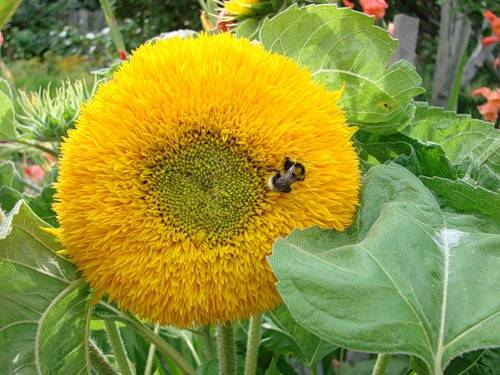

Beekeepers have appreciated the high honey content of large sunflower flowers. In general, from whatever side you look, there is no better culture than sunflower - this is oil, and honey, and medicine, and seeds. Even waste is used: first-class cake is used for halva production, second-class cake is used for fodder, and husk is an excellent fuel. But no matter how useful the sunflower is in agriculture, one should not forget about the decorative properties of this plant. After all, the acquaintance with him began as with a decorative culture, which was not in vain called the "flower of the sun".
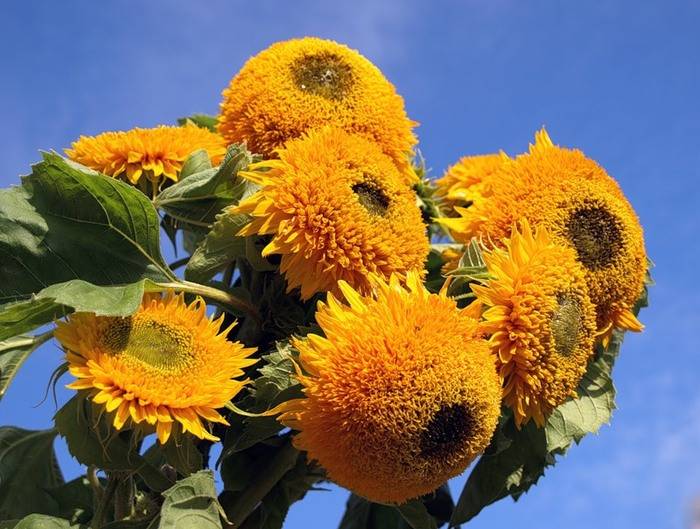

Each of us is well acquainted with the sunflower, but not all agree to call it a “flower”. Now in Europe it is a fashionable and popular flower of various shapes and colors. Here it is just beginning to gain its popularity as a landscape decor. More than 150 varieties of ornamental sunflower are cultivated and sold in the world today, three quarters of which have been bred by breeders in recent years. Helianthus - Helianthus (from the Greek "helios" - the sun and "anthos" - flowers), gaining popularity, is rapidly becoming fashionable.
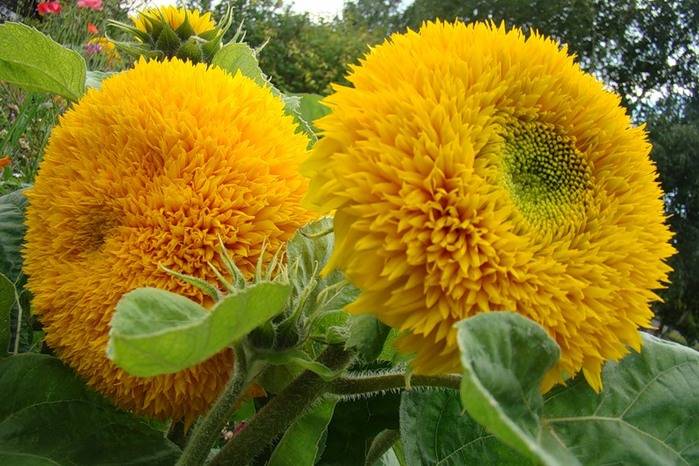

The seeds of this plant were brought by the fourth expedition of Christopher Columbus from Mexico in 1510 and sown in the Madrid Botanical Garden. From here it spread throughout Europe, and later around the world under the name "Grass of the Sun", or "Peruvian Flower of the Sun". Since the second half of the 16th century, sunflower has been studied and described by many breeders, and each gives it its own name: Heba solis, Flos solis, Solindianus, Corona solis, Solis flos peruvianus, Helianthemon peruvianum. Heliotropism (orientation to the sun) of inflorescences explains the unanimity of authors from different countries who saw in this flower a semblance of the sun.
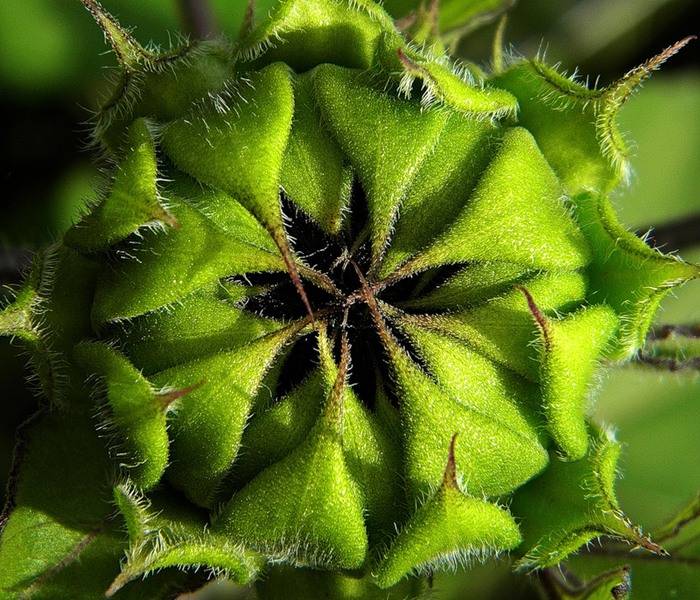

Once in Europe, sunflower remained only an ornamental crop for a long time. He evokes general admiration and interest not only among botanists, poetry is written about him, he is depicted in paintings. It is characteristic that in his famous series of paintings "Sunflowers", Vincent van Gogh depicted precisely decorative, and not oil-bearing forms of sunflower.
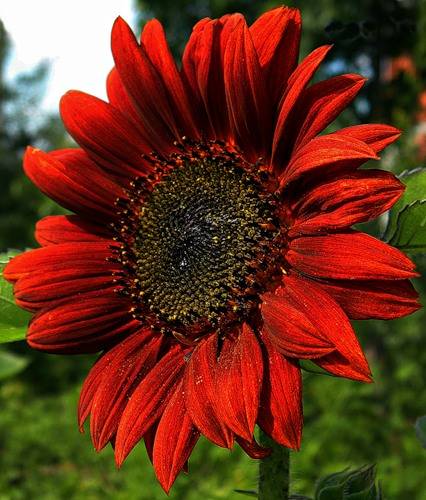

If we keep the chronology of the emergence of sunflower culture in Europe from the beginning of the 16th century, then at least 300 years have passed since its first utilitarian use. The peasant Bokarev from the Alekseevskaya Sloboda of the Voronezh province in 1829 for the first time manually obtained sunflower oil from the seeds of an overseas flower. The new product was a huge success. Already in 1833, the first horse-drawn industrial oil mill began to operate, and in 1865 the first steam oil mill began operating. From flower greenhouses, sunflower entered the fields of the southern regions of Russia, then - Europe, later - Argentina and China, and, finally, already in the XX century. returned to his historical homeland - America - in a new capacity.
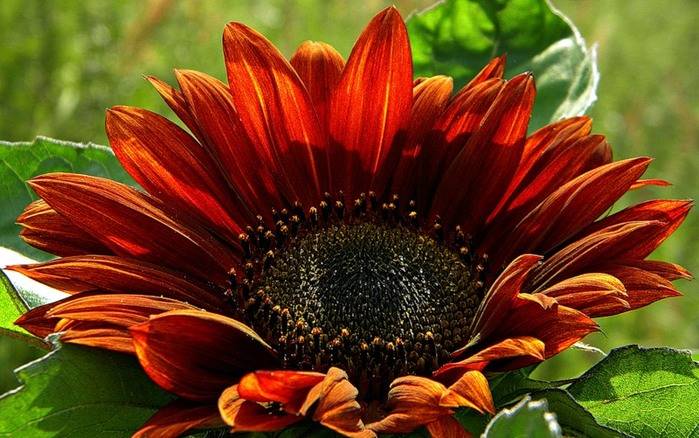

In our country, the decorative value of culture was almost completely lost, but in Europe, North America, Japan, South Africa, on the contrary, interest in this culture was growing.Breeders, armed with modern methods of genetics and biotechnology, created new varieties and hybrids. Every year there are novelties, each novelty is a new word in the breeding of a species. In Austria, not far from Vienna, the popular among tourists "Sunflower Park" has opened, which presents more than 40 species of wild relatives of our "friend", hundreds of modern oilseed varieties and hybrids, almost all of them are decorative forms.
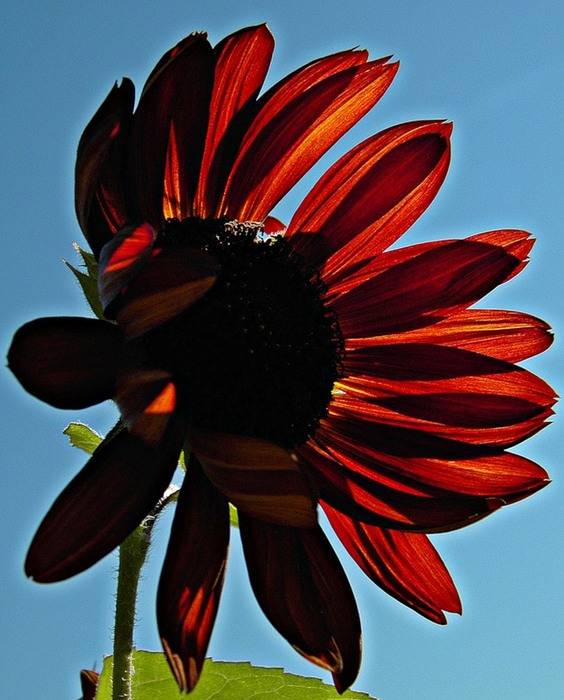

Decorative sunflowers in our gardens have a rather short history. They are used in cut to create original bouquets, which are stored in vases with water for more than two weeks.
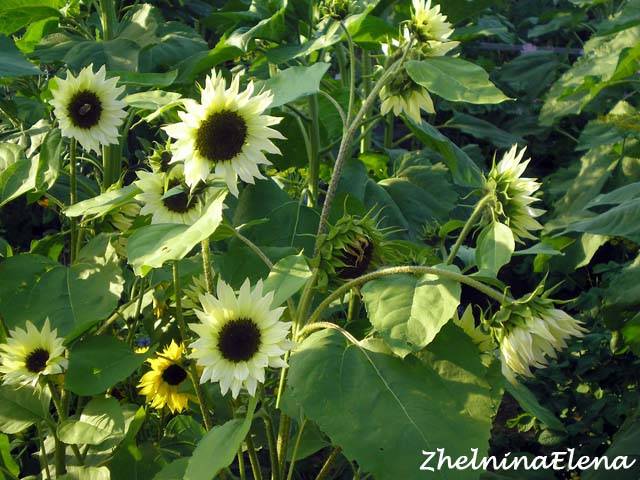

The wave of the growing popularity of helianthus has reached us. An increasing number of varieties enter our market, many design studios import fresh flowers from Holland and Germany for arrangement.
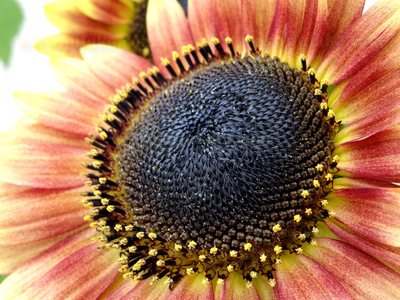

There are several reasons for the rapid rise in global popularity of sunflower. The main one is the unpretentiousness of the plant: the sown seeds sprout and grow together. Only the first time you need to take care of watering and soil fertility, and then the roots penetrate deep into the ground, which helps to overcome both low fertility and a slight drought. With repeated sowing (April-August), it is easy to achieve continuous flowering from early July to the first (usually in November) frosts.
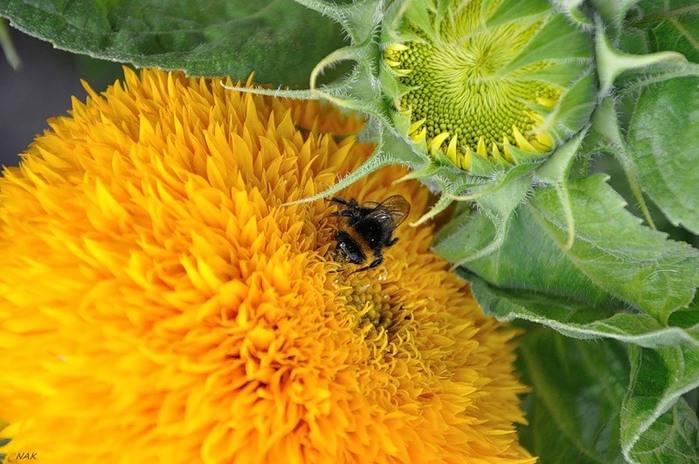

Another reason is the extraordinary diversity of the plants themselves. You can use varieties of any desired height - from 3-meter giants to 30-centimeter dwarfs, with various types of branching or single-stemmed. This allows you not only to decorate an unsightly barn wall with bright flowers, but to create a flower bed of any shape, to make a composition of lush-blooming babies in pots near the porch, which is easy to replace with a new one in mood.
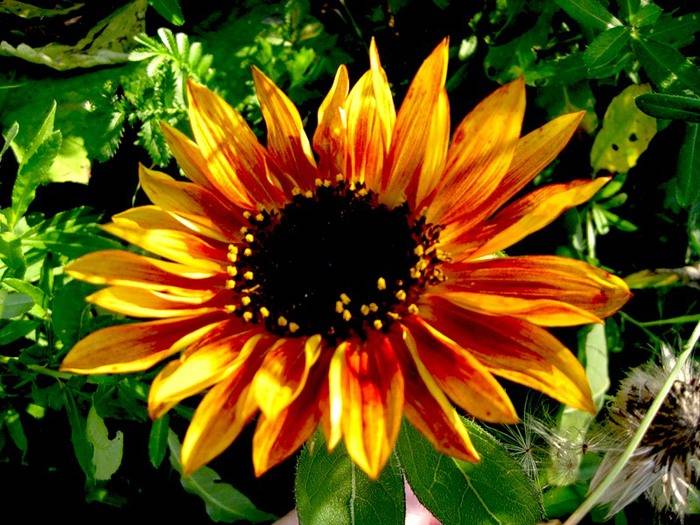

The next factor is the color palette. Modern varieties, besides the well-known ones, also have other basic colors: white, baked milk, ivory, lemon, apricot, orange, each can be combined with anthocyanin and give colors from creamy pink and red to purple-burgundy, almost black.
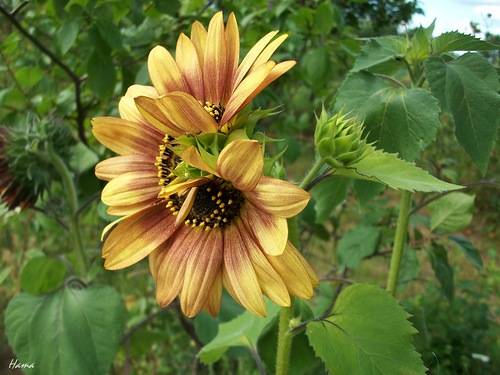

The variety of sizes, shapes, structure of inflorescences of decorative sunflowers is also amazing. The diameter of the flowers is very different: from 5-6 cm to 17-20 cm. In addition to the usual flat-bottomed inflorescences, there is a whole series of double varieties. In some, the inflorescences are similar to the inflorescence of a chrysanthemum, in others - gerberas, in others - dahlias, the rest are their own types: various flat and convex star-shaped shapes. The shape of the petals is also impressive with its diversity: round, long, elongated with all kinds of bends, twists, etc.
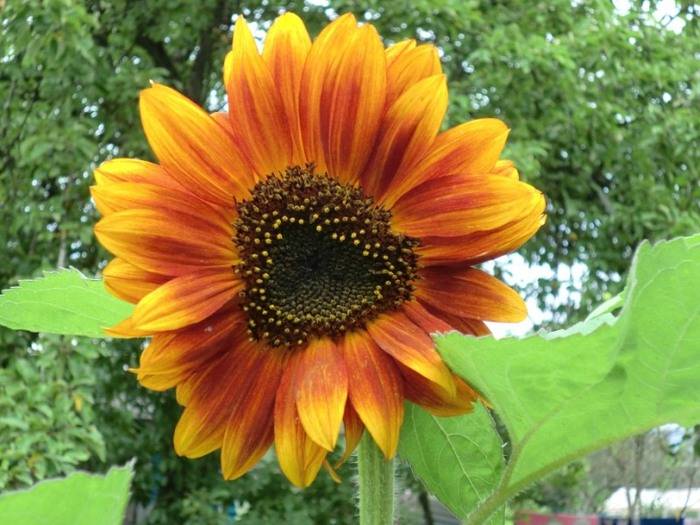

Varieties of decorative sunflowers
differ in height, miniature have a height of 30 cm, and large up to 3 meters. They differ in color - white, yellow, orange, red-brown, vanilla and new colors appear. The shape of the petals is long, round, curved, twisted.
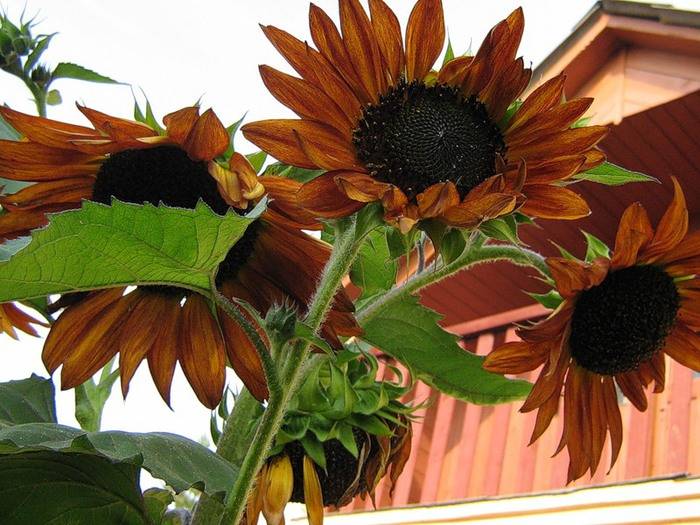

Growing ornamental sunflower
Seeds are planted during May - August to get extended flowering until the coldest days. Planting depth is up to 2 cm, the distance between plants depends on the size of the plants, since large sunflowers look better in single plantings, and low ones should also not grow too densely to show all their lush beauty. But group plantings are also possible with the creation of waves of high, medium and low colors. You can also use sunflower to decorate your hedge. The place is chosen sunny, quiet, unheated, well fertilized land. Faded flowers and whole plants are cut to preserve the decorative plantings and shed the flowering period.
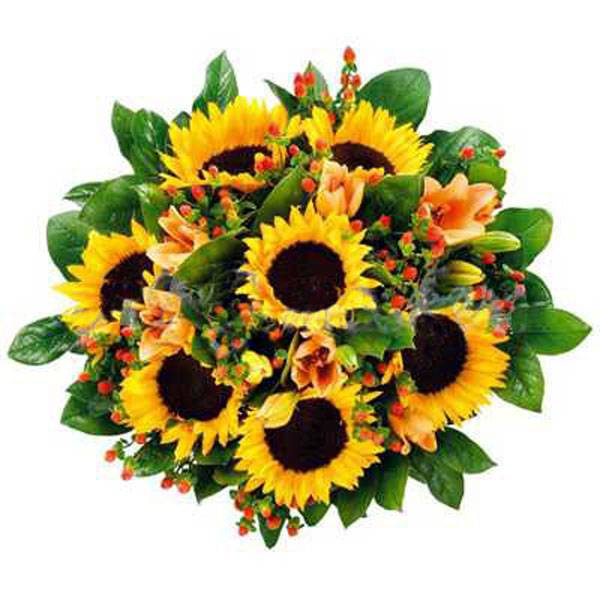

It can be assumed that in the near future the varietal potential of the culture will expand to several hundred, or even thousands of varieties.
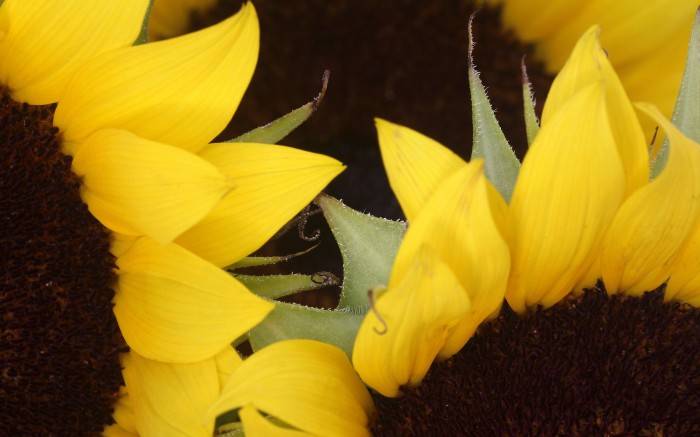

The last reason on the list is the functionality of modern hybrids. Sunflower is a bee-pollinated crop that produces a lot of nectar and pollen.It was the abundant pollen that previously held back its widespread use in cutting (unremovable yellow spots and painful allergies). Now a way has been invented to create an exact but sterile copy for any variety. It is these new modern hybrids that are magnificent pollen-free inflorescences. With proper cutting and transportation, the flower in a vase lasts up to 10-12 days.
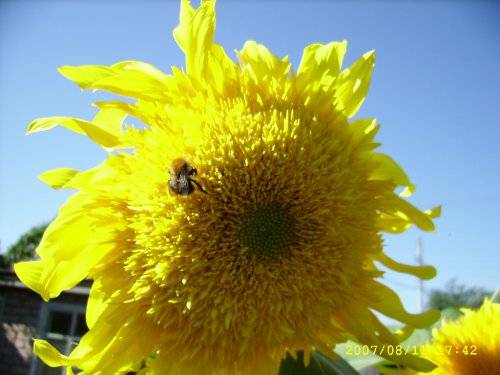

The most popular Decorative Sunflowers are divided into groups:
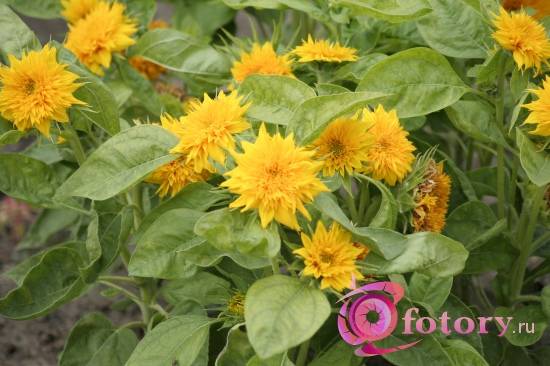

1.
Sunflower Variegated - with variegated leaves;
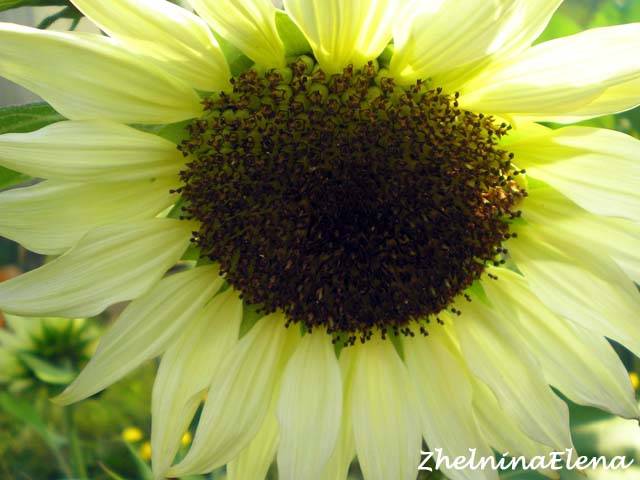

2. California sunflower - with double and semi-double inflorescences, mainly from reed flowers
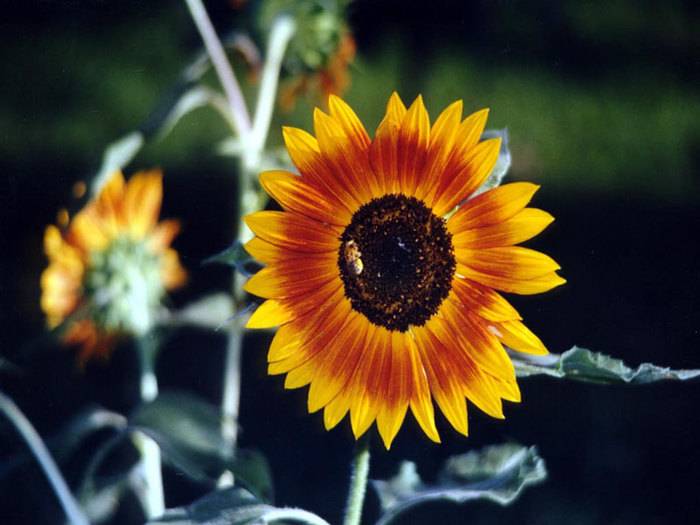

3.
Sunflowers Round and Bloated - this group has terry spherical inflorescences, with a predominance of tubular flowers


4. Sunflowers Round Multi-flowered - this group has a lot of inflorescences located at the top and on the sides of the stem up to 1 m high.The bush looks like a flowering hill
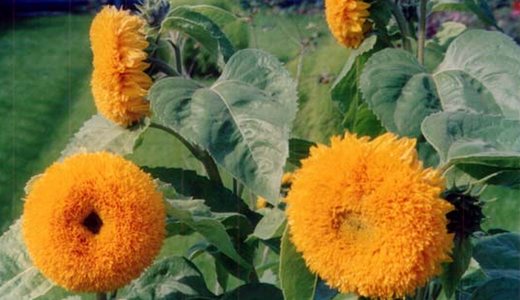

Sunflower variety "Teddy Bear", very large round, up to 20 cm in diameter, bright yellow terry inflorescences, reminiscent of a plush toy. Plant up to 1 m high with a strong, highly branched stem. Flowering occurs in mid-summer and lasts until autumn.
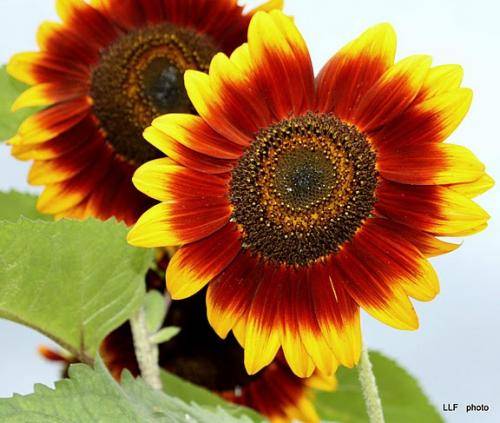

No less interesting Sunflower variety "Red Sun" with its bright red-brown inflorescences and a darker center on a rather high, up to 2 m tall, strong stem. Flowering is profuse and long lasting. This plant is visible from afar.
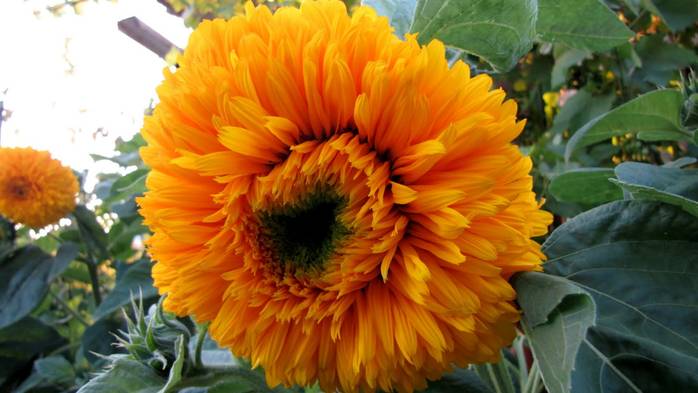

Sunflower variety "Dachnik" - dwarf variety for Ornamental Sunflowers, only up to 0.5 m tall, but with a strong peduncle. Due to the low height of the plant, it looks spectacular in the foreground of the border.
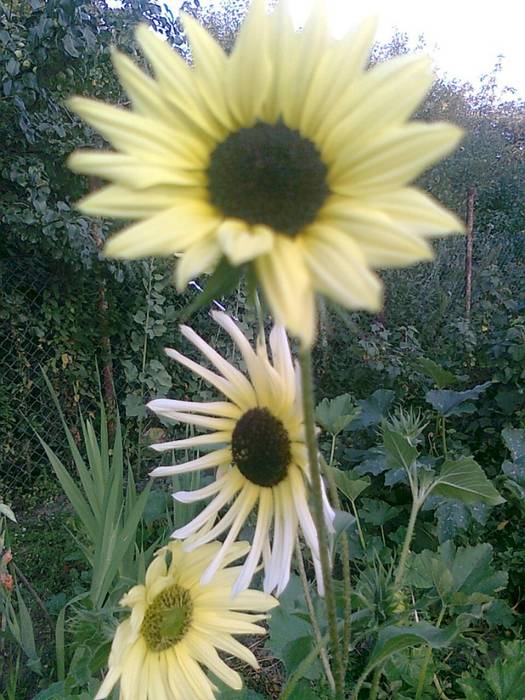

Inflorescences differ in unusual color Sunflower varieties "Light of the Moon" - they are light lemon-yellow, large, with many smaller lateral flowers.
What you need to know about caring for helianthus
Both industrial and decorative sunflower varieties are not very picky about growing conditions and care. Highlights:
- Protect the seedlings from weeds by harrowing before sprouting.
- The sunflower is highly dependent on moisture. Water it often, but in small portions, to avoid stagnant water at the root.
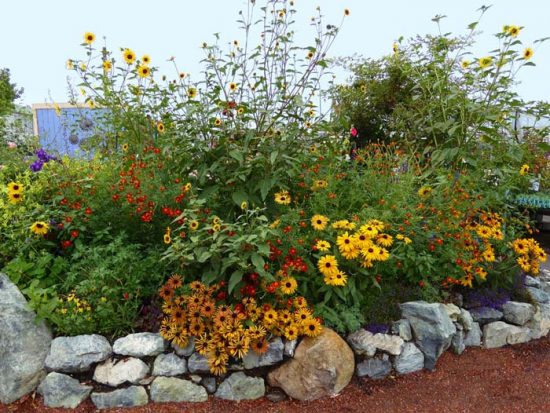

Decorative sunflowers in the flowerbed
- For a good effect of the underground part of the flower with oxygen and moisture, weed and loosen the flower bed regularly.
- After the first leaves appear, it is advisable to make a breakthrough. An untimely procedure will lead to mutual oppression of seedlings and poor development of flower baskets. Small flowers form on plants that grow too tightly together.
- During the growing season, a sunflower requires 3-5 weeding.
- The sunflower will develop more actively if you feed it a couple of times a season. Better - liquid fertilizers. For the first application, in the phase of 2 true leaves, use full mineral fertilizers. For the second, at the stage of tying baskets, nitrogen-phosphorus. If necessary, repeat the second dressing at the beginning of flowering.
- Fading inflorescences need to be cut off. After the last basket withers, cut the plant at the root. You cannot dig it up, because the root system is connected with the neighboring ones.
- Among the enemies-pests of sunflower are birds, as well as insects: sunflower moth, longhorn beetle and barbel.
Simple care of helianthus will help to decorate your site with a vibrant, colorful and sunny decor.
Varietal variety of helianthus
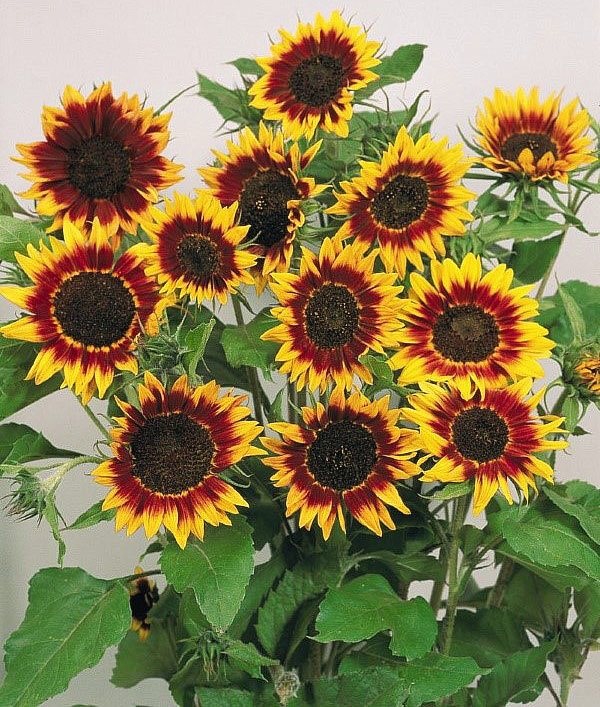

Today there are almost 200 species of helianthus that are used in decorative floriculture, but breeders do not stop there, inventing new varieties of this unique plant. Among them there are both dwarf specimens not exceeding 30 cm in height, and real giants over 3 m in height. The color of the caps is no less varied: from the characteristic yellow color to unique white petals and even dark purple.What can we say about terry varieties - their stuffed lush heads will be a flower bed decoration.
Scientists have also worked on the very shape of the inflorescence, breeding varieties similar to dahlias, chrysanthemums or gerberas. And the very shape of the petals differs from the standard type of sunflower - they can be round or oval, curved or twisted.
It is worth noting that most modern hybrids are completely sterile. They do not have pollen, therefore, an allergic reaction to the sunflower bouquet is excluded.
Depending on the shape of the plant, the following species groups of the helianthus flower are distinguished:
- variegated (with a pattern on the leaves);
- Californian (with stuffed inflorescences);
- multi-flowered (inflorescences in plural numbers are located along the entire stem, giving the sunflower the appearance of a pyramid).
The total height of the bush is distinguished:
- giant varieties "growing" from 1.8 to 3 m with large caps up to 30 cm in diameter;
- medium-sized sunflowers with a height of 1.2 m;
- dwarf varieties not exceeding 60 cm in height.
Among the most beautiful species of helianthus, it is worth noting the following varieties:
- Moulin Rouge with a burgundy velvet hat;
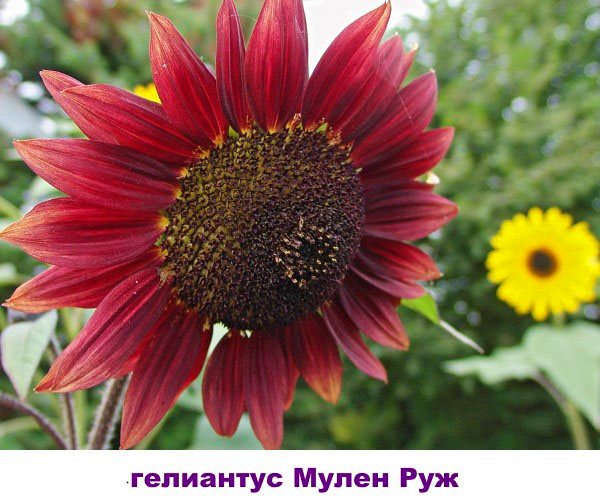

- giant sunflower Titan;
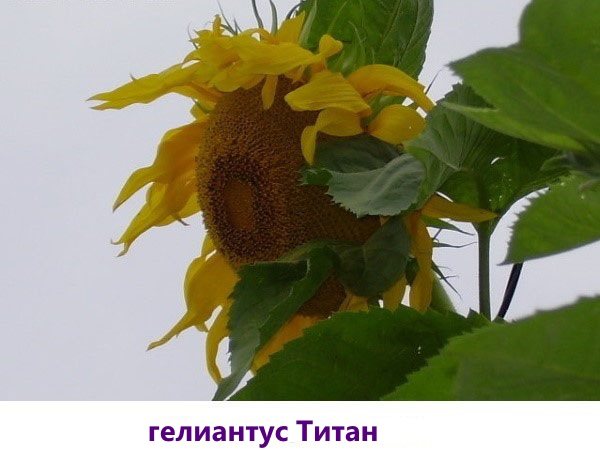

- dwarf Teddy Bea;
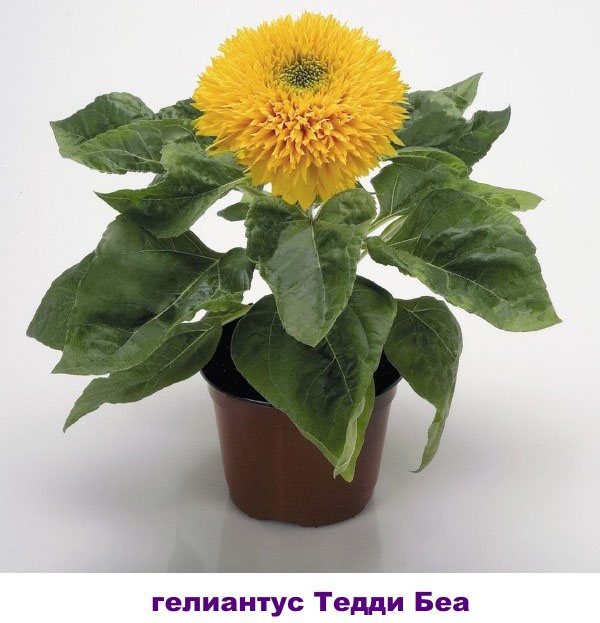

- Moonlight with lemon petals;
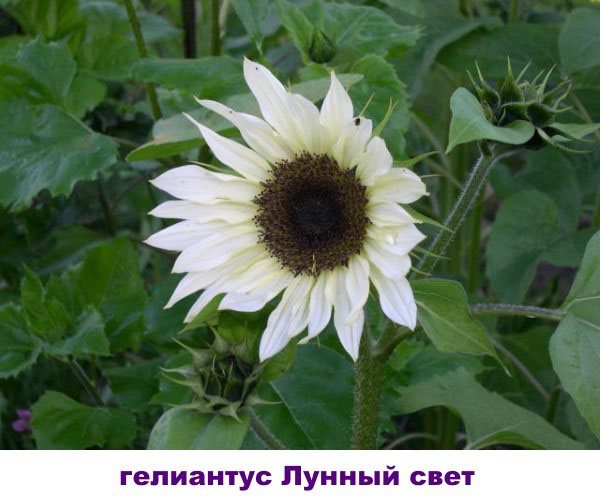

- terry Sun King;
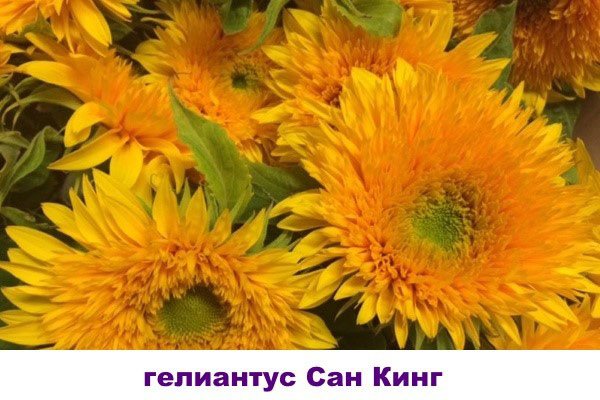

- Vanilla Ice with lemon petals and a large black heart.
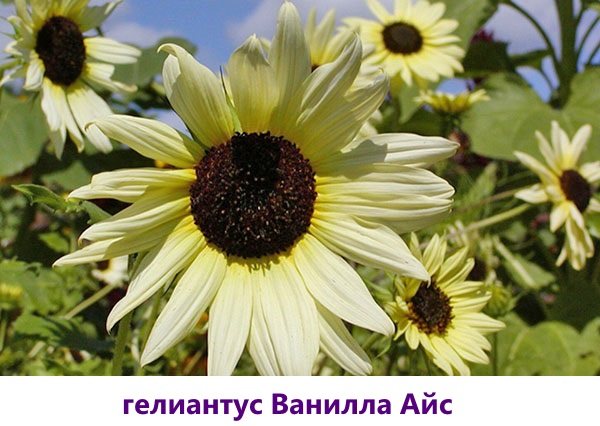

Recipes
Infusion for appetite:
- 1 tbsp marginal flowers of sunflower;
- 1 tbsp. boiling water.
Pour boiling water over the flowers and let it brew for an hour. Strain. Drink 1/3 cup three times daily before meals. Also, this infusion is recommended for oncology as a diuretic: 1/2 cup three times a day for 10 days, then a break for 5 days and again 10 days of admission. Antipyretic infusion:
- 2 tbsp marginal flowers of sunflower;
- 1 tbsp. boiling water.
Pour boiling water over the petals, let it brew for 10 minutes and strain. Drink at night for colds.
Another recipe for antipyretic infusion:
- 1 s.l. chopped fresh sunflower stalk;
- 1 tbsp. boiling water.
Pour boiling water over the stems, let it brew for an hour and strain. Drink 1/2 cup 2-3 times a day 30 minutes before meals. Infusion with an increase in blood sugar:
- 1/2 tbsp. sunflower seeds;
- 1 liter of boiling water.
Pour boiling water over the washed black seeds in a thermos overnight. Strain in the morning. Drink during the day between meals. Recommended course of treatment: 14 days of admission, 14 days - a break, 14 days of admission, another break for 14 days and repeat the course of admission a third time. Decoction for bronchitis and bronchial asthma:
- 1 tbsp fresh marginal sunflower flowers;
- 1 tbsp chopped fresh sunflower leaves;
- 1 tbsp. boiling water.
Pour boiling water over the vegetable raw materials, boil for 10 minutes over low heat, and then let it brew for an hour. Strain. Add the resulting broth with boiled water to the original volume. Drink 2-3 tablespoons warm 3-4 times daily before meals. Also, this broth will help with malaria and whooping cough.
Decoction for coughs, bronchitis, whooping cough and tonsillitis:
- 3 tbsp crushed sunflower seeds;
- 500 ml of water.
Pour the seeds over with water and simmer over low heat until the volume of the liquid has evaporated by a quarter. Then strain the broth. You can sweeten it. Take 1 tablespoon three times a day for 10-14 days. Broth for prostatitis:
- 4/5 cup dried sunflower root
- 3 liters of water.
Fill the roots with water and boil, and then let the broth brew for 3-4 hours. Drink 1 liter a day. Decoction for kidney disease:
- 2 handfuls of dried sunflower stalks
- about 3 liters of cold water.
Place the stems in a 3 liter jar and cover with water. Let it brew for an hour, and then drain the water, boil and refill the stems in the jar with it. Cover the jar with gauze and leave to infuse for a day. Then strain. Take half a glass three times a day. Recommended course of treatment: a month of admission, a week off and repeat the course. In total, you should take 3-4 courses.
Decoction for salt deposition:
- 1 tbsp. crushed dry sunflower roots;
- 3 liters of boiling water.
Pour boiling water over the roots and boil for 10 minutes over low heat. Strain. Drink 2/3 cup of the broth 2-3 times a day. Store the broth in the refrigerator - you need to use it in three days. The recommended course of treatment is 1 month. Arthritis decoction (for external use):
- 1 tbsp. chopped sunflower root;
- 1.5 liters of water.
Pour the sunflower root with water, bring to a boil and boil for 10-15 minutes, and then let the broth brew for 2 hours. Strain. Use for compresses and rubbing. Tincture for psoriasis:
- marginal flowers of sunflower;
- 70% alcohol or vodka.
Fill any glass jar 2/3 full with flowers and top with vodka. Let the product sit for 14 days. Strain. Use to wipe the area affected by psoriasis.
Also, this tincture can be used for colds: 1 tablespoon three times a day 20 minutes before meals - no more than 3 days! Pneumonia Tincture: Fill a glass bottle with sunflower petals and fill with vodka. Let it brew for 14 days. Strain. Take 1 teaspoon three times daily.
Tincture for neurosis, neurasthenia:
- 3 tbsp crushed marginal sunflower flowers;
- 1 tbsp. vodka.
Pour vodka over the flowers and place in a dark place for 7 days. Strain after a week. Take 35-40 drops, diluted in a little water, twice a day, 20 minutes before meals. Tincture for gout:
- 1 sunflower flower;
- vodka.
Take a medium-sized sunflower flower (without a root), chop it and place it in a liter jar, filling 1/3 of its volume. Then fill the jar with the flower with vodka up to the top. Let it brew for two weeks. Shake the container with the mixture periodically. Strain after 14 days. Take 1 tablespoon twice daily 20 minutes before meals. Also use tincture for overnight rub.
With herpes, an edge sunflower flower is applied to the rash, previously scalded with boiling water. To treat a heel spur, take the pulp of the sunflower remaining after removing the seeds, boil it and apply it hot to the heel. Fix the sunflower pulp on top with plastic and a warm bandage. Annual sunflower oil is also used in folk medicine: it is taken internally as a laxative, used for rubbing with pain in the joints and for healing wounds (compresses are made from boiled oil).
Features of agricultural technology
Ornamental sunflowers are flowers that prefer sunny locations. This culture needs fertile soil with an abundance of nutrients. The soil needs to be well drained. Acidic soils are not suitable for this culture. The area where the plant will be planted must be protected from the wind.
The culture has the ability to take in large quantities of nutrients from the soil; next year it is recommended to plant beans or beans, the so-called green manure.
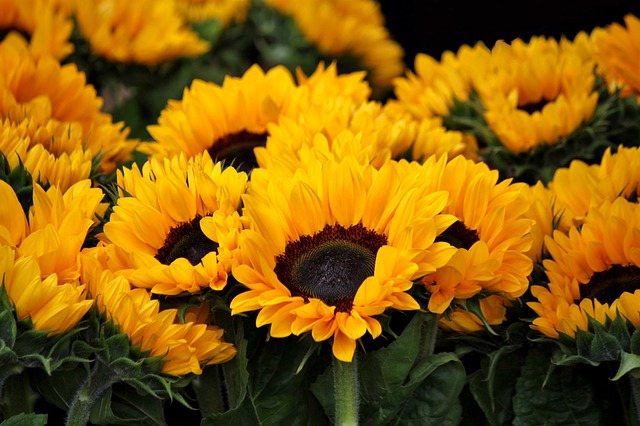

Numerous varieties of this culture are widely used in landscape design. Borders are created from the plant, planted in group plantings, dwarf varieties are placed in rock gardens, hedges are created from high varieties, the height of which may be higher than the height of a person.
Additional Information: decorative sunflowers will look great in any flower arrangement. Delphiniums, chrysanthemums, chamomile, lavender will look great next to helianthus.
Useful properties of seeds
Observing how sunflowers are planted almost everywhere, the question of the usefulness of this culture involuntarily arises.
Scientists have long studied the seed, or more correctly, the achene (this is the name of the sunflower fruit) and identified a number of its qualities. They found that eating sunflower seeds:
- prevents the development of atherosclerosis;
- serves as a barrier to the development of cancer;
- improves heart function;
- helps to improve the condition of hair, skin, nails;
- provides the body with useful substances, since it contains calcium, phosphorus, potassium, magnesium, iron, vitamins A, groups B, E;
- prevents early aging of the body.
An unpretentious occupation - clicking seeds - in itself becomes a wonderful action to distract from sad thoughts. Many smokers have gotten rid of this addiction with the help of seeds. The nutritional value of the product is so high that it can quickly and easily satisfy hunger.
Chamomile yellow
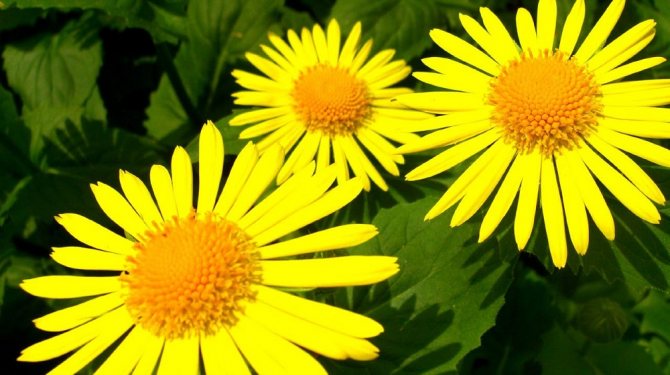

Yellow chamomile is also called Doronicum. There are several breeding varieties of this species of decorative chamomile.
Both the ligulate and tubular flowers of this chamomile are colored bright yellow and lemon yellow. The diameter of the inflorescences varies from 4 to 10 cm in diameter.
Glossy dark green leaves grow on tough and sparsely branched stems of a flower bush; basal leaves form a rosette. After flowering, the foliage of yellow chamomile does not dry out and retains a fresh look until the end of summer. The height of dwarf bushes is 20-25 cm. Tall chamomile grows up to 70 cm.
Care
A decorative sunflower does not require hassle. Plentiful regular watering is all he needs. Stagnation of water should be avoided, but this is regulated by proper planting - the soil should be loose, moisture-permeable, well-drained. In such soil, it is impossible to flood the plant. Weak growth and dull flowering are possible unless the plant lacks space and light, these issues are also resolved at the planting stage.
To speed up flowering, stepchildren and small buds, which can be seen under the main one, should be removed.
Flowering usually occurs 75-80 days after sowing, but there are now earlier varieties.
It also doesn't hurt, although it's optional:
- Loosening the soil around the plant.
- Weed removal.
- Cutting off faded inflorescences is necessary not only to stimulate flowering, but also to make the flower bed more decorative.
- Abundant watering once a week, in case of drought - if you need a lush flowering.
Fertilizers are required only for poor soils. Any organic fertilizer at the start of the growing season will do.
Wintering plants
Decorative rabbit - care and maintenance at home
Perennial varieties must be cut off after repeated frosts so that about 7 cm remains above the ground. Treat the plant and soil with any fungicide to prevent the appearance of fungus. Cover the plant so that it does not freeze.
The sunflower got its name because its head looks like the sun and follows it all day. When caring for this decorative flower, you need to be careful and inspect it regularly to prevent disease or the appearance of pests. It will be much easier to care for the crop if you familiarize yourself with the specifics of planting and caring for it in advance.
Sowing with seeds
The seeds are pre-soaked in gauze soaked in water. Wood ash can be used - it is a good source of minerals. Ash solution preparation: 2 tbsp. tablespoons per 1 liter of water are insisted for two days, the seeds are kept in the resulting solution for 3-6 hours.
In open ground, you can sow sunflower from the beginning of May and later, the main thing is that it is warm, the culture does not like frost. The distance between the seeds is from 30 to 70 cm, depending on the height of the future adult plant. Embedding depth - 2-3 cm, but not more.
Perennial sunflowers (Jerusalem artichoke) can be propagated by dividing the bush, at the end or beginning of the growing season, that is, either in early spring or late in autumn.
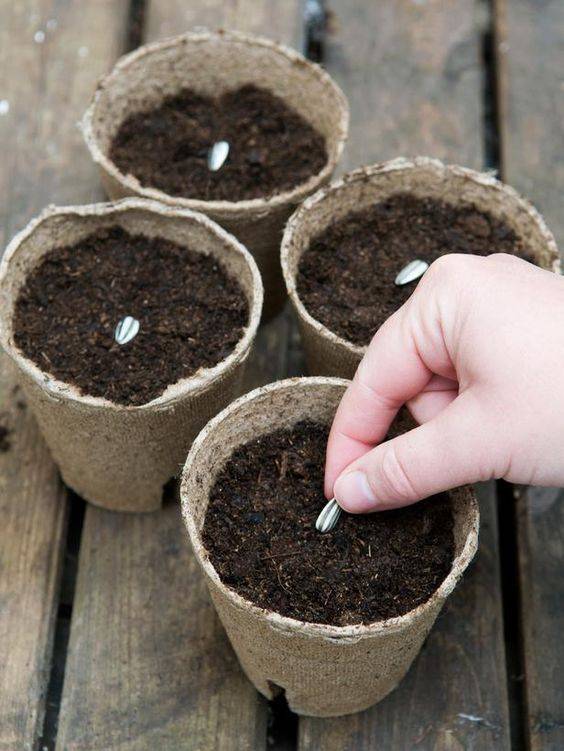

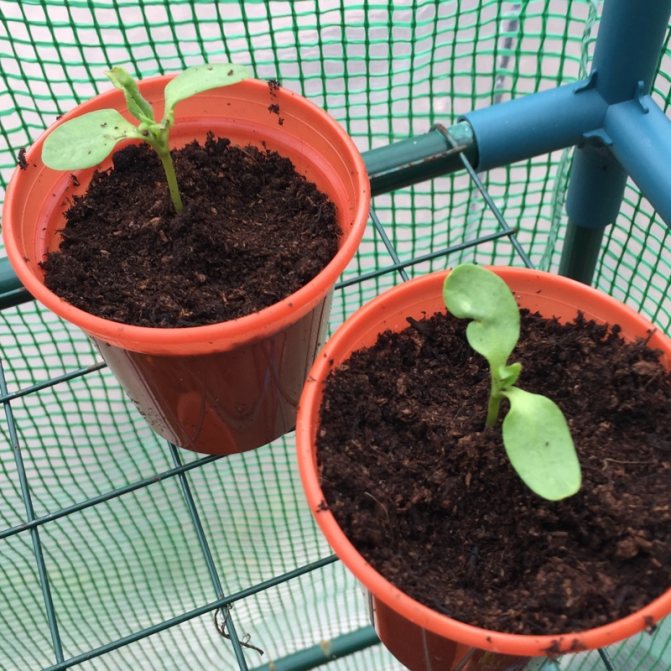

Origin story
Sunflower Bear or Teddy Bear is called a legendary variety. It is considered decorative, it does not have seeds that are suitable for food, but the inflorescences are amazing.
For the first time, decorative sunflowers were brought to European countries by the expedition of Christopher Columbus from Northern Mexico. They came to Russia under Peter I. The unusual and beautiful flower instantly became an object of admiration.
Later, breeders bred many varieties of ornamental sunflower, among which the Bear Cub variety stands out most clearly.
Now it is no longer possible to say who exactly bred this variety, but it is absolutely certain that this was done in Soviet times by our breeders.
The bear cub, thanks to its unpretentiousness and beauty, immediately attracted the gardeners. For several decades now, it has been considered one of the most popular varieties of decorative sunflowers.
The use of sunflower in floristry
The floriculture and floristry industry is increasingly paying attention to plants that were previously not customary to use for decoration and bouquets.
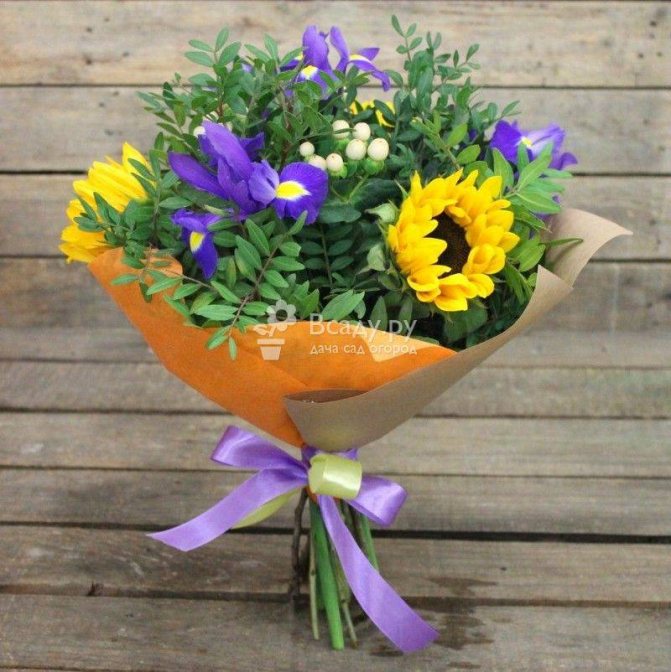

Sunflower - photo of a beautiful bouquet
On September holidays, the hero of the most daring and stylish bouquets is a decorative sunflower along with asters, chrysanthemums, gladioli and even roses.
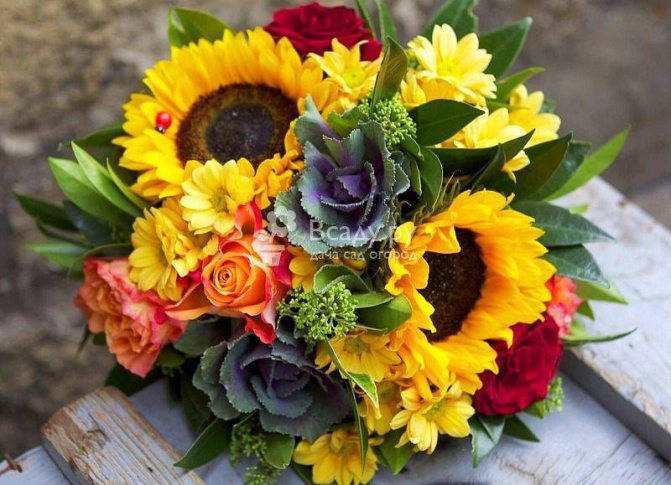

Stylish autumn bouquet with sunflower
Thanks to the powerful stem, the sunflower stands in a bouquet for a long time, without losing its freshness and texture. And the bright petals of the flower add freshness to the dwelling, and cheer up the residents.
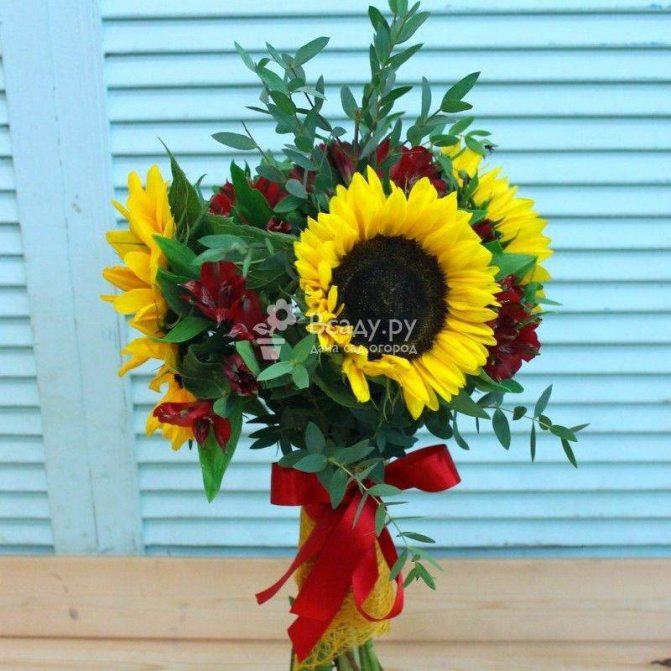

Decorative sunflowers - bouquet photo

